

April 2024
Updated: 1 April 2024
Welcome to the night skies of Autumn, featuring Canis Major, Eridanus, Gemini, Cancer, Leo, Virgo, Hydra, Carina and Crux
Note: To read this webpage with mobile phones or tablets, please use them in landscape format, i.e. the long screen axis should be horizontal.

The Alluna RC-20 Ritchey Chrétien telescope was installed in March, 2016.
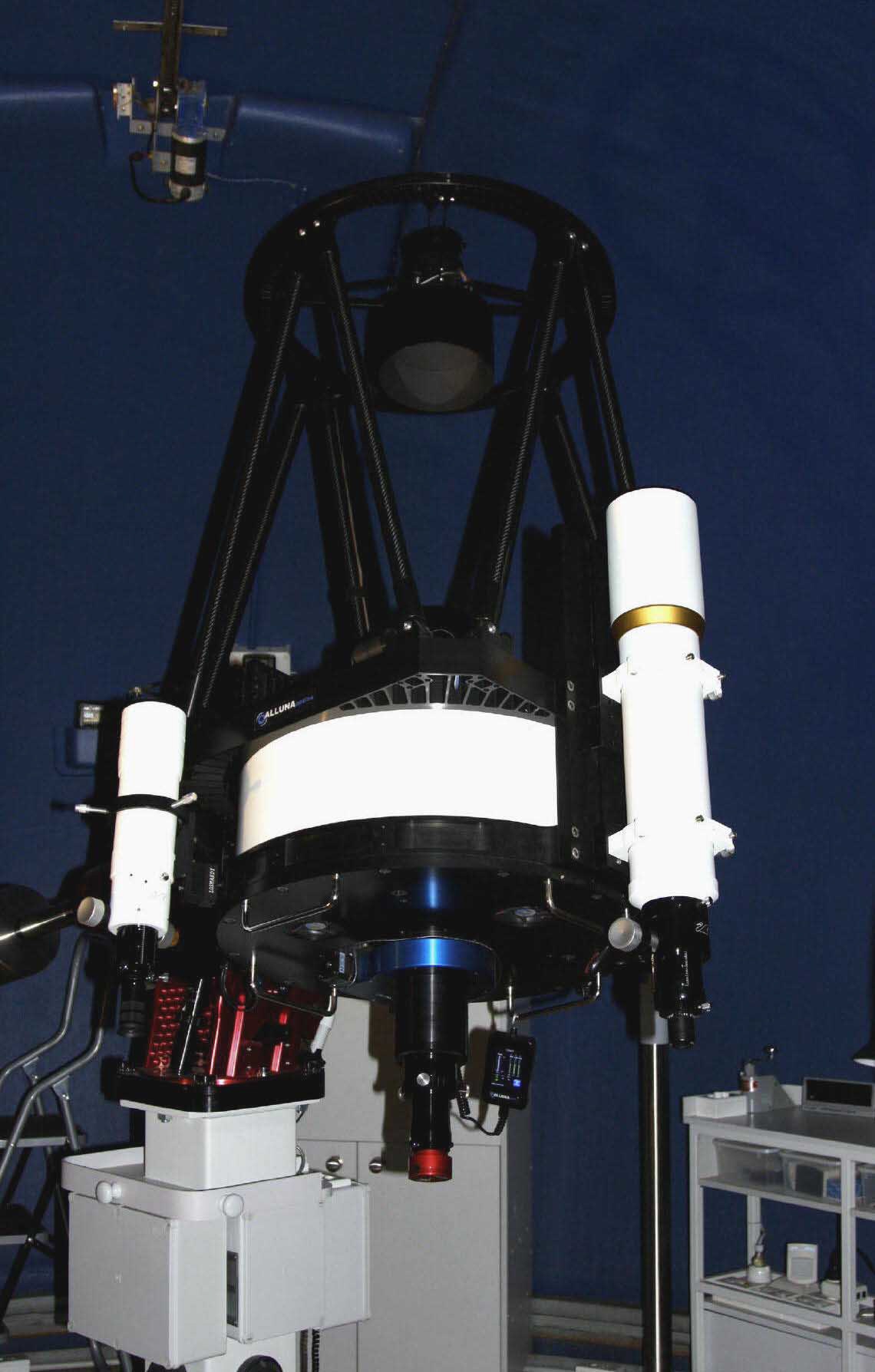
The 20-inch telescope is able to locate and track any sky object (including Earth satellites and the International Space Station) with software called TheSkyX Professional, into which is embedded a unique T-Point model created for our site with the telescope itself.
Explanatory Notes:
Rise and set times are given for the theoretical horizon, which is a flat horizon all the
way round the compass, with no mountains, hills, trees or buildings to obscure the view. Observers will have to make allowance for their own actual horizon.
Transient phenomena are provided for the current month and the next. Geocentric phenomena are calculated as if the Earth were fixed in space
as the ancient Greeks believed. This viewpoint is useful, as otherwise rising and setting times would be meaningless. In the list of geocentric events, the nearer object is
given first.
When a planet is referred to as ‘stationary’, it means that its movement across the stellar background appears to have ceased, not that
the planet itself has stopped. With inferior planets (those inside the Earth’s orbit, Mercury and Venus), this is caused by the planet heading either directly
towards or directly away from the Earth. With superior planets (Mars out to Pluto), this phenomenon is caused by the planet either beginning or ending its
retrograde loop due to the Earth’s overtaking it.
Apogee and perigee: Maximum and minimum distances of the Moon or artificial satellite from the Earth.
Aphelion and perihelion: Maximum and minimum distances of a planet, asteroid or comet from the Sun.
Eclipses always occur in pairs, a lunar and a solar but not necessarily in that
order, two weeks apart.
The
meridian is a semicircle starting from a point on the horizon that is exactly due north from the observer, and arching up into the sky to the zenith and
continuing down to a point on the horizon that is exactly due south. On the way down it passes through the South Celestial Pole which is 26.6 degrees above the
horizon at Nambour. The elevation of the South Celestial Pole is exactly the same as the observer's latitude, e.g. from Cairns it is 16.9 degrees above the
horizon, and from Melbourne it is 37.8 degrees. The Earth's axis points to this point in the sky in the southern hemisphere, and to an equivalent point in the
northern hemisphere, near the star Polaris, which from Australia is always below the northern horizon.
All astronomical objects rise until they reach the meridian, then they begin to set. The act of crossing or 'transitting' the meridian is called 'culmination'.
Objects closer to the South Celestial Pole than its altitude above the southern horizon do not rise or set, but are always above the horizon, constantly
circling once each sidereal day. They are called 'circumpolar'. A handspan at arm's length with fingers spread covers an angle of approximately 18 - 20 degrees.
Your closed fist at arm's length is 10 degrees across. The tip of your index finger at arm's length is 1 degree across. These figures are constant for most people, whatever
their age. The Southern Cross is 6 degrees high and 4 degrees wide, and Orion's Belt is 2.7 degrees long. The Sun and Moon average half-a-degree (30 arcminutes)
across.
mv = visual magnitude or brightness. Magnitude 1 stars are very bright, magnitude 2 less so, and
magnitude 6 stars are so faint that the unaided eye can only just detect them under good, dark conditions. Binoculars will allow us to see down to magnitude
8, and the Observatory telescope can reach visual magnitude 17 or 22 photographically. The world's biggest telescopes have detected stars and galaxies as faint as
magnitude 30. The sixteen very brightest stars are assigned magnitudes of 0 or even -1. The brightest star, Sirius, has a magnitude of -1.44. Jupiter can reach -2.4, and
Venus can be more than 6 times brighter at magnitude -4.7, bright enough to cast shadows. The Full Moon can reach magnitude -12 and the
overhead Sun is magnitude -26.5. Each
magnitude step is 2.51 times brighter or fainter than the next one, i.e. a magnitude 3.0 star is 2.51 times brighter than a magnitude 4.0. Magnitude 1.0
stars are 100 times brighter than magnitude 6.0 (5 steps each of 2.51 times, 2.51x2.51x2.51x2.51x2.51 = 2.515 =
The Four Minute Rule
How long does it take the Earth to complete one rotation? No, it's not 24 hours - that is the time taken for the Sun to cross
the meridian on successive days. This 24 hours is a little longer than one complete rotation, as the curve in the Earth's
orbit means that it needs to turn a fraction more (~1 degree of angle) in order for the Sun to cross the meridian again. It is called a 'solar day'. The stars,
clusters, nebulae and galaxies are so distant that most appear to have fixed positions in the night sky on a human time-scale, and for a star to return to
the same point in the sky relative to a fixed observer takes 23 hours 56 minutes 4.0916 seconds. This is the time taken for the Earth to complete exactly one
rotation, and is called a 'sidereal day'.
As our clocks and lives are organised to run on solar days of 24 hours, and the stars circulate in 23 hours 56 minutes approximately, there is a four minute
difference between the movement of the Sun and the movement of the stars. This causes the following phenomena:
1. The Sun slowly moves in the sky relative to the stars by four minutes of time or one degree of angle per day. Over the
course of a year it moves ~4 minutes X 365 days = 24 hours, and ~1 degree X 365 = 360 degrees or a complete circle. Together, both these facts mean that after the course of a
year the Sun returns to exactly the same position relative to the stars, ready for the whole process to begin again.
2.
For a given clock time, say 8:00 pm, the stars on consecutive evenings are ~4 minutes or ~1 degree further on than they were the previous night. This means
that the stars, as well as their nightly movement caused by the Earth's rotation, also drift further west for a given time as the weeks pass. The stars
of autumn, such as Orion, are lost below the western horizon by mid-June, and new constellations, such as Sagittarius, have appeared in the east. The stars
change with the seasons, and after a year, they are all back where they started, thanks to the Earth's having completed a revolution of the Sun and returned to
its theoretical starting point.
We can therefore say that the star patterns we see in the sky at 11:00 pm tonight will be identical to those
we see at 10:32 pm this day next week (4 minutes X 7 = 28 minutes earlier), and will be identical to those of 9:00 pm this date next month or 7:00 pm the month after. All
the above also includes the Moon and planets, but their movements are made more complicated, for as well as the Four Minute Drift with
the stars, they also drift at different rates against the starry background, the closest ones drifting the fastest (such as the Moon or Venus), and the most distant ones
(such as Saturn or Neptune) moving the slowest.
Observing astronomical objects depends on whether the sky is free of clouds. Not only that, but there are other factors such as wind,
presence of high-altitude jet streams, air temperature, humidity (affecting dew formation on equipment), transparency (clarity of the air), "seeing" (the amount of air
turbulence present), and air pressure. Even the finest optical telescope has its performance constrained by these factors. Fortunately, there is an Australian website that
predicts the presence and effects of these phenomena for a period up to five days ahead of the current date, which enables amateur and professional
astronomers to plan their observing sessions for the week ahead. It is called "SkippySky". The
writer has found its predictions to be quite reliable, and recommends the website as a practical resource. The website is at
http://skippysky.com.au and the detailed Australian data are at
http://skippysky.com.au/Australia/ .
Solar System
Sun:
The Sun begins the month in the zodiacal constellation of Pisces, the Fishes. It crosses into Aries, the Ram on April 18. Note: the Zodiacal constellations used in astrology have significant differences with the familiar astronomical constellations both in size and the timing of the passage through them of the Sun, Moon and planets.
The Moon is tidally locked to the Earth, i.e. it keeps its near hemisphere facing us at all times, while its far hemisphere is never seen from Earth. This tidal locking is caused by the Earth's gravity. The far side remained unknown until the Russian probe Luna 3 went around the Moon and photographed it on October 7, 1959. Now the whole Moon has been photographed in very fine detail by orbiting satellites. The Moon circles the Earth once in a month (originally 'moonth'), the exact period being 27 days 7 hours 43 minutes 11.5 seconds. Its speed is about 1 kilometre per second or 3679 kilometres per hour. The Moon's average distance from the Earth is 384 400 kilometres, but the orbit is not perfectly circular. It is slightly elliptical, with an eccentricity of 5.5%. This means that each month, the Moon's distance from Earth varies between an apogee (furthest distance) of 406 600 kilometres, and a perigee (closest distance) of 356 400 kilometres. These apogee and perigee distances vary slightly from month to month. In the early 17th century, the first lunar observers to use telescopes found that the Moon had a monthly side-to-side 'wobble', which enabled them to observe features which were brought into view by the wobble and then taken out of sight again. The wobble, called 'libration', amounted to 7º 54' in longitude and 6º 50' in latitude. The 'libration zone' on the Moon is the area around the edge of the Moon that comes into and out of view each month, due to libration. This effect means that, instead of only seeing 50% of the Moon from Earth, we can see up to 59%.
The animation loop below shows the appearance of the Moon over one month. The changing phases are obvious, as is the changing size as the Moon comes closer to
Earth at perigee, and moves away from the Earth at apogee. The wobble due to libration is the other feature to note, making the Moon appear to sway from side
to side and nod up and down.
.gif)
TOTAL, APRIL 9:
The next total eclipse of the Sun will not be visible
from any part of Australia, except via the Internet ( click
Australia will experience a total solar eclipse on July 22, 2028. It will
strike the Western Australian mainland in the Kimberley District in the middle
of the day, and head south-east past Alice Springs, Birdsville and Dubbo to
Sydney, then across the Tasman Sea to Dunedin in New Zealand. It will be worth
waiting for !
Lunar Phases:
Last
Quarter:
May 1
May
Moon at 8 days after New, as on
April 17. The photograph above shows the Moon when approximately eight days after New, just after
First Quarter. A rotatable view of the Moon, with ability to zoom in close to the surface (including the far side), and giving detailed
information on each feature, may be downloaded
New Moon:
April 09 04:21 hrs
diameter = 33.2'
Lunation #1253 begins
New Moon:
May 8
13.22 hrs
diameter = 32,6'
Lunation #1254 begins
Last Quarter:
May 31
03:13 hrs diameter =
32.3''
Lunar Orbital Elements:
May
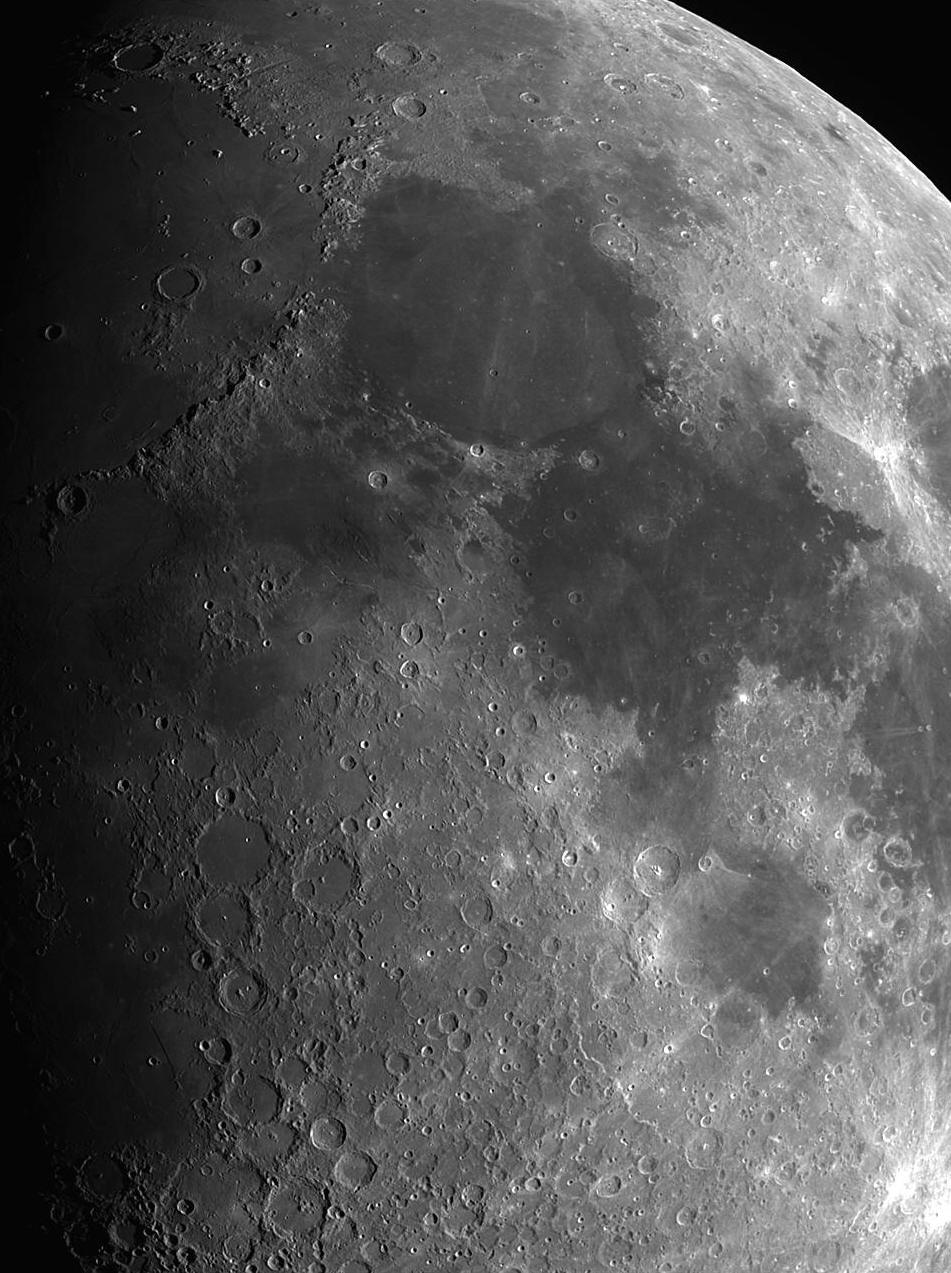
Lunar Feature for this Month
Each month we describe a lunar crater, cluster of craters, valley, mountain range or other object, chosen at random, but one with interesting attributes. A recent photograph from our Alluna RC20 telescope will illustrate the object. As all large lunar objects are named, the origin of the name will be given if it is important. This month we will look at a long graben or rift valley known as the Rima Ariadaeus.
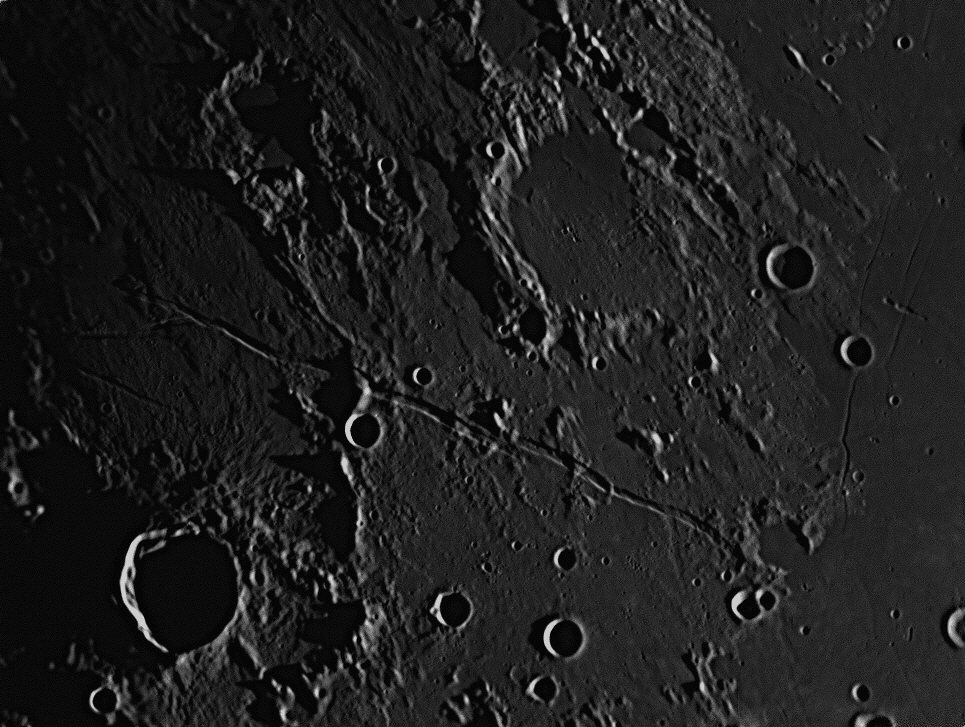
The Rima Ariadaeus is found near the centre of the Moon's near side. It has a length of 220 kilometres, and its width averages 7 kilometres. At its western end it is connected to the
Rima Hyginus system which is shown in images
The Rima Ariadaeus is a spectacular valley-cleft that was discovered by Schrӧter in 1792 and is easily seen in today's small telescopes. It begins in a rim-less
depression filled with lava called Hyginus Z (28 kilometres
diameter, one-third of the way down the left margin) and heads towards the lower right-hand corner. Soon it is joined by another cleft which is shallower and part of the Rima Hyginus system. From this junction the Rima Ariadaeus
becomes wider and deeper, and the walls on each side very steep. At this point the valley enters a rugged area and then climbs over a mountain range just to the north of a 13 kilometre recent impact crater called Silberschlag. The
valley then proceeds in a more-or-less straight line, except that at 60 kilometres from Silberschlag there is a break in the valley, the remaining part it being displaced north by about 5 kilometres. There must be a north-south
fault line below the visible surface to have enabled such a large section of the moonscape to have been moved north such a distance after the rille had already been formed. Three north-south clefts near the right-hand margin called the
Rimae Sosigenes may provide a clue. The displaced section of the Rima Ariadaeus continues east-south-east for 100 kilometres to its end near the young, bright 12-kilometre crater Ariadaeus. It passes over two small
ridges on its way, ending at the western wall of the lava-flooded crater Ariadaeus E (24 kilometres). Before it reaches the end, a less-sharply defined branch heads south.
Julius Caesar (91 kilometres) is a large and battered formation, open to the east. Recent lava flows have covered the northern portion of the floor which is almost featureless, while the southern portion is peppered with craterlets.
Just to the east of Julius Caesar is an undamaged flat-floored crater called Sosigenes (18 kilometres diameter).
Agrippa
Agrippa was a Greek astronomer in the first century AD. The only thing that is known about him regards an astronomical observation that he made in 92 AD. Ptolemy writes that in the twelfth year of the reign of Domitian, on the
seventh day of the Bithynian month Metrous, Agrippa observed the occultation of a part of the Pleiades star cluster by the southernmost part of the Moon. The purpose of Agrippa's observation was probably to check the
precession of the equinoxes, which was discovered by Hipparchus.
Whilst in Egypt in 46 BCE, Caesar commissioned Sosigenes of Alexandria to reform the Roman calendar, which was now over two months ahead of the seasons. Sosigenes suggested that they adopt King Ptolemy

Click here for the Lunar Features of the Month Archive
April 1: Moon 2.6º north of the star Alnasl (Gamma2 Sagittarii, mv= 2.98) at 17:05 hrs
April 1: Moon 1.8º north of the star Kaus Media (Delta Sagittarii, mv= 2.72) at 21:39 hrs
April 2: Moon 2.8º south of the star Kaus Borealis (Lambda Sagittarii, mv= 2.92) at 00:31 hrs
April 2: Mercury at eastern stationary point at 8:13 hrs
April 2: Moon 1.1º south of the star Nunki (Sigma Sagittarii, mv= 2.02) at 14:12 hrs
April 2: Moon 2.65º north of the star Ascella (Zeta Sagittarii, mv= 2.6) at 15:51 hrs
April 3: Moon 1.6º south of Pluto at 21:29 hrs
April 5: Moon 1.05º south of the star Deneb Algedi (Delta Capricorni, mv= 2.85) at 12:09 hrs
April 6: Limb of Moon 41 arcminutes south of Mars at 16:19 hrs
April 6: Limb of Moon 10 arcminutes south of Saturn at 20:20 hrs
April 7: Limb of Moon 8 arcminutes north of Neptune at 19:13 hrs
April 8: Limb of Moon 14 arcminutes north of Venus at 01:16 hrs
April 9: Moon 1.3º south of Mercury at 12:23 hrs
April 9: Uranus of the star Botein (Delta Arietis (mv= 4.34) at 16:42 hrs
April 11: Moon 3.7º north of Jupiter at 4:39 hrs
April 11: Mars 26 arcminutes north of Saturn at 8:42 hrs
April 11: Moon 3.4º north of Uranus at 7:08 hrs
April 11: Moon occults the star Alcyone (Eta Tauri, mv= 2.85) between 23:56 and 00:33 hrs
April 12: Mercury at inferior conjunction at 8:56 hrs
April 13: Moon occults the star Elnath (Beta Tauri, mv= 1.65) between 13:44 and 14:34 hrs
April 16: Moon 1.3º south of the star Pollux (Beta Gemiorum, mv= 1.15) at 01:30 hrs
April 19: Mercury 1.7º north of Venus at 18:39 hrs
April 21: Jupiter 30 arcminutes south of Uranus at 13:42 hrs
April 22: Pluto at western quadrature at 2:48 hrs (diameter = 0.1")
April 22: Neptune 1.9º north of the star 27 Piscium (mv= 4.9) at 5:31 hrs
April 23: Moon 1.9º north of the star Spica (Alpha Virginis, mv=0.98) at 13:28 hrs
April 25: Mercury at western stationary point at 22:41 hrs
April 26: Moon 1.1º south of the star Dschubba (Delta Scorpii, mv= 1.86) at 16.18 hrs
April 26: Moon 2.3º north of the star Pi Scorpii (mv= 2.89) at 16:51 hrs
April 27: Moon occults the star Alniyat (Sigma Scorpii, mv= 2.9) between 03:16 and 4:24 hrs
April 27: Limb of Moon 17 arcminutes north of the star Antares (Alpha Scorpii, mv= 0.88) at 8:21 hrs
April 27: Moon 2.3º north of the star Tau Scorpii (mv= 2.82) at 11:11 hrs
April 28: Moon 2.3º north of the star Alnasl (Gamma2 Sagittarii, mv= 2.98) at 21:01 hrs
April 29: Moon 1.3º north of the star Kaus Media (Delta Sagittarii, mv= 2.72) at 5:13 hrs
April 29: Moon 2.7º south of the star Kaus Borealis (Lambda Sagittarii, mv= 2.92) at 09:15 hrs
April 29: Mars 15 arcminutes south of Neptune at 14:33 hrs
April 29: Moon 1.1º south of the star Nunki (Sigma Sagittarii, mv= 2.02) at 17:55 hrs
April 29: Moon 2.5º north of the star Ascella (Zeta Sagittarii, mv= 2.6) at 19:37 hrs
May 1: Moon 2º south of Pluto at 4:43 hrs
May 2: Limb of Moon 35 arcminutes south of the star Deneb Algedi (Delta Capricorni, mv= 2.85) at 18.19 hrs
May 2: Pluto at western stationary point at 22:45 hrs (diameter = 0.1")
May 4: Limb of Moon 4 arcminutes south of Saturn at 9:24 hrs
May 5: Limb of Moon 20 arcseconds south of Neptune at 3:33 hrs - grazing occultation ?
May 5: Limb of Moon 42 arcminutes north of Mars at 13:18 hrs
May 6: Moon 4.1º north of Mercury at 17:14 hrs
May 7: Moon 3.3º north of Venus at 23:52 hrs
May 8: Moon 3.7º north of Uranus at 22:10 hrs
May 9: Moon 4.1º north of Jupiter at 1:56 hrs
May 9: Moon occults the star Alcyone (Eta Tauri, mv= 2.85) between 7:58 and 8:23 hrs
May 10: Mercury at greatest elongation west (26º 11') at 5:36 hrs
May 10: Saturn 1º north of the star Situla (Chi Aquarii, mv= 4.93) at 13:50 hrs
May 11: Limb of Moon 19 arcminutes south of the star Elnath (Beta Tauri, mv= 1.65) at 1:04 hrs
May 11: Saturn 43 arcminutes south of the star Phi Aquarii (mv= 4.22) at 4:59 hrs
May 13: Moon 1.3º south of the star Pollux (Beta Gemiorum, mv= 1.15) at 07:22 hrs
May 13: Uranus in conjunction with the Sun at 19:08 hrs (diameter = 3.4")
May 18: Venus 27 arcminutes south of Uranus at 21:54 hrs
May 19: Jupiter in conjunction with the Sun at 4:59 hrs (diameter = 32.7")
May 20: Moon 1.3º south of the star Spica (Alpha Virginis, mv=0.98) at 21:19 hrs
May 23: Venus 11 arcminutes north of Jupiter at 18:29 hrs
May 23: Moon 1.8º south of the star Dschubba (Delta Scorpii, mv= 1.86) at 23.50 hrs
May 24: Limb of Moon 17 arcminutes north of the star Alniyat (Sigma Scorpii, mv=2.9) at 10:28 hrs
May 24: Limb of Moon 51 arcminutes north of the star Antares (Alpha Scorpii, mv= 0.88) at 13:06 hrs
May 26: Moon 2.1º north of the star Alnasl (Gamma2 Sagittarii, mv= 2.98) at 5:55 hrs
May 26: Moon 2.1º north of the star Kaus Media (Delta Sagittarii, mv= 2.72) at 11:18 hrs
May 26: Moon 2.1º south of the star Kaus Borealis (Lambda Sagittarii, mv= 2.92) at 13:35 hrs
May 26: Moon 1.6º south of the star Nunki (Sigma Sagittarii, mv= 2.02) at 23:07 hrs
May 26: Uranus 2.4º south of the star 63 Arietis (mv=5.8) at 12:28 hrs
May 25: Neptune 1.7º north of the star 29 Piscium (mv= 5.13) at 00:29 hrs
May 29: Moon 1.2º south of the star Deneb Algedi (Delta Capricorni, mv= 2.85) at 22.24 hrs
May 31: Mercury 1.3º south of Uranus at 16:11 hrs
Mercury:
Venus:
This, the brightest planet, was an 'evening star' in the western sky for most of 2023. It passed through inferior conjunction (between the Earth and the Sun) on August 13, and then moved to the pre-dawn sky as a 'Morning Star', where it still is. Currently in the constellation of Pisces, it rises(The coloured fringes to the second, fourth and fifth images below are due to refractive effects in our own atmosphere, and are not intrinsic to Venus itself. The planet was closer to the horizon when these images were taken than it was for the first and third photographs, which were taken when Venus was at its greatest elongation from the Sun.)
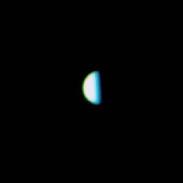
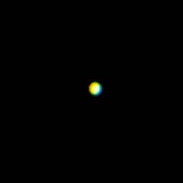
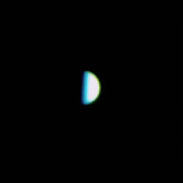
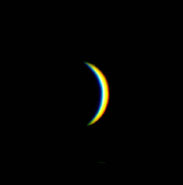
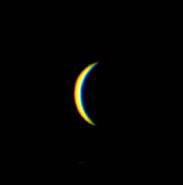
October 2023 May-July 2024 January 2025 March 2025 April 2025
C
Because Venus is visible as the 'Evening Star' and as the 'Morning Star', astronomers of ancient times believed that it was two different objects. They called it Hesperus when it appeared in the evening sky and Phosphorus when it was seen before dawn. They also realised that these objects moved with respect to the so-called 'fixed stars' and so were not really stars themselves, but planets (from the Greek word for 'wanderers'). When it was finally realised that the two objects were one and the same, the two names were dropped and the Greeks applied a new name Aphrodite (Goddess of Love) to the planet, to counter Ares (God of War). We use the Roman versions of these names, Venus and Mars, for these two planets.
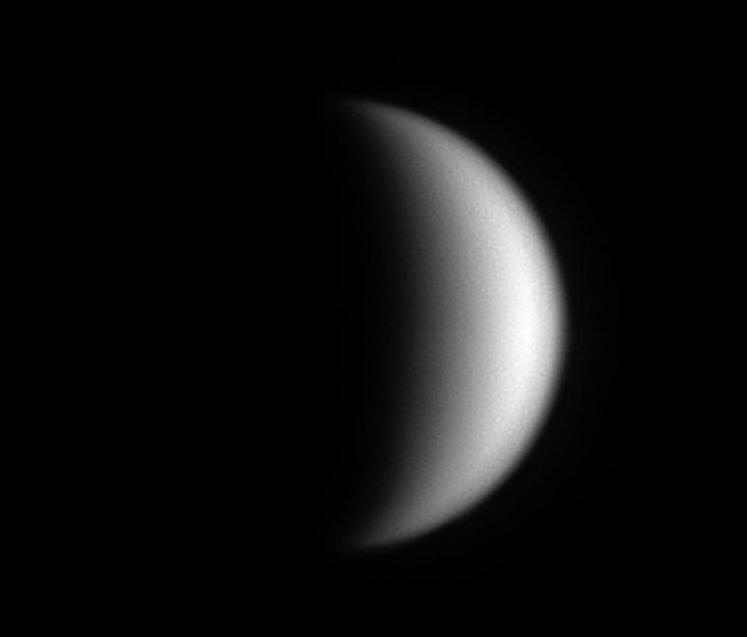
Venus at 6.55 pm on September 7, 2018. The phase is 36 % and the angular diameter is 32 arcseconds.
Mars:
At the beginning of April, the red planet is cruising through the constellation Aquarius. It crosses into Pisces on April 24. It is in the pre-dawn eastern sky, having been in conjunction with the Sun on November 18. It is on the far side of its orbit, very small and faint, but as the year progresses, the Earth will begin to catch up to Mars, and its diameter and brightness will increase. On April 1 its angular diameter will be 4.48 arcseconds and its brightness will be magnitude 1.18. On that date it can be found rising above the horizon (almost due east) at 3:23 am. It will be 6.8 degrees above the planet Saturn. By April 11, the two planets will be together, only 26 arcminutes apart at 6:09 am. By the end of the month, the angular diameter of Mars will have increased to 4.74 arcseconds and its magnitude will have increased to 1.12. On that day it will rise at 3:10 am. As Mars is moving towards Neptune as seen from Earth, on April 29 the two planets will be only 2 arcminutes apart. Unfortunately, this close encounter will occur at 2:33 pm in the afternoon. Mars will have other close approaches - with Uranus on July 16 and with Jupiter on August 15.The waning crescent Moon will join Mars and Saturn on the mornings of April 6 and May 5.
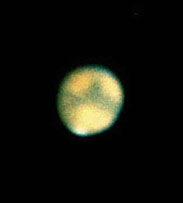
In this image, the south polar cap of Mars is easily seen. Above it is a dark triangular area known as Syrtis Major. Dark Sinus Sabaeus runs off to the left, just south of the equator. Between the south polar cap and the equator is a large desert called Hellas. The desert to upper left is known as Aeria, and that to the north-east of Syrtis Major is called Isidis Regio. Photograph taken in 1971.
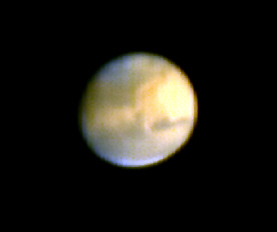

Mars photographed from Starfield Observatory, Nambour on June 29 and July 9, 2016, showing two different sides of the planet. The north polar cap is prominent.
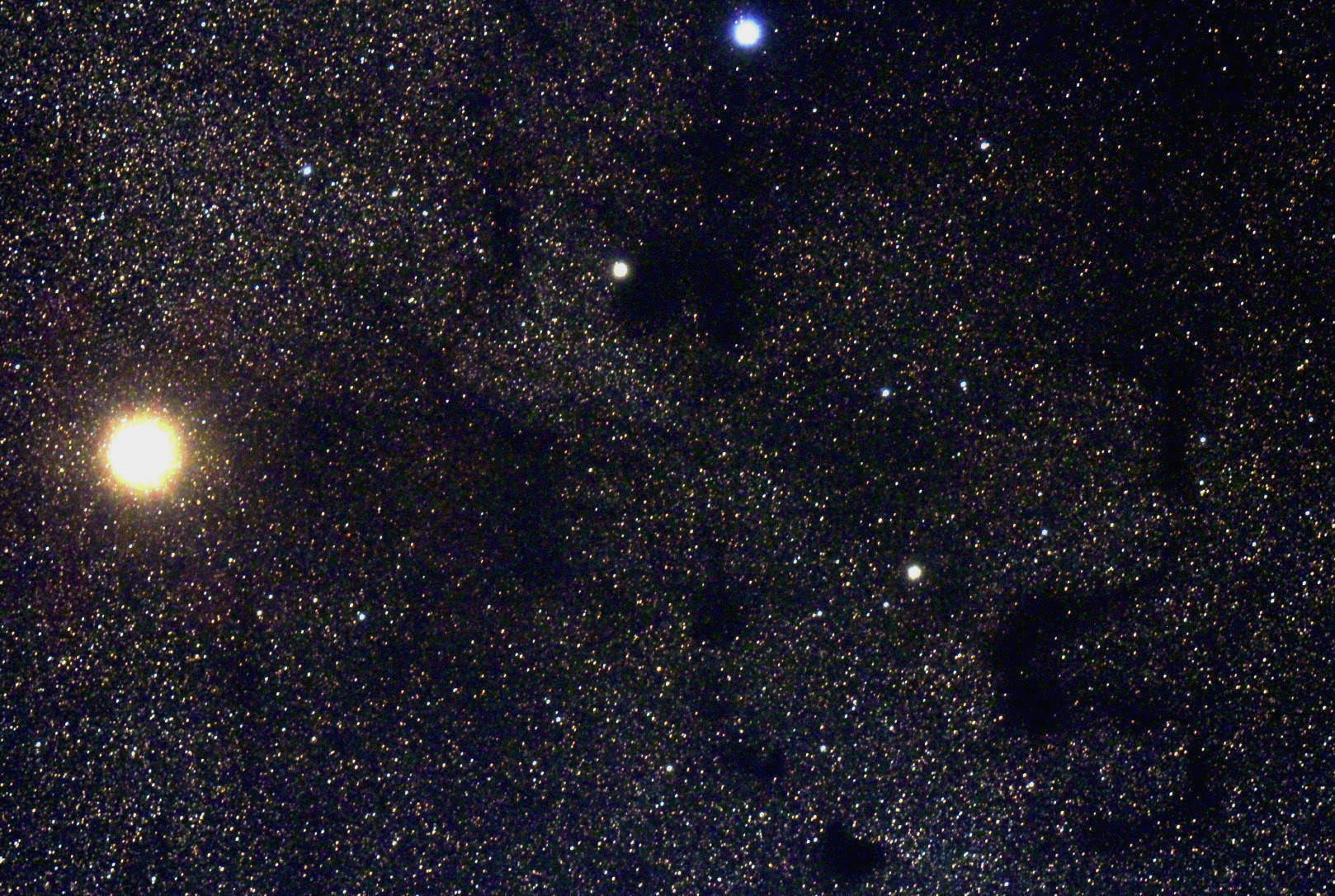
Brilliant Mars at left, shining at magnitude 0.9, passes in front of the dark molecular clouds in Sagittarius on October 15, 2014. At the top margin is the white fourth magnitude star 44 Ophiuchi. Its type is A3 IV:m. Below it and to the left is another star, less bright and orange in colour. This is the sixth magnitude star SAO 185374, and its type is K0 III. To the right (north) of this star is a dark molecular cloud named B74. A line of more dark clouds wends its way down through the image to a small, extremely dense cloud, B68, just right of centre at the bottom margin. In the lower right-hand corner is a long dark cloud shaped like a figure 5. This is the Snake Nebula, B72. Above the Snake is a larger cloud, B77. These dark clouds were discovered by Edward Emerson Barnard at Mount Wilson in 1905. He catalogued 370 of them, hence the initial 'B'. The bright centre of our Galaxy is behind these dark clouds, and is hidden from view. If the clouds were not there, the galactic centre would be so bright that it would turn night into day.
Mars near opposition, July 24, 2018

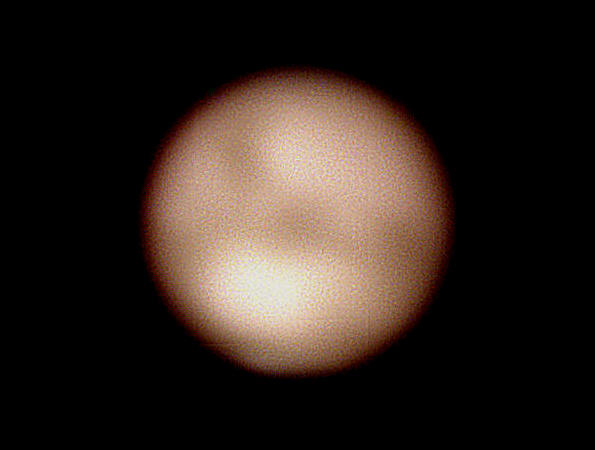

Mars, called the red planet but usually coloured orange, in mid-2018 took on a yellowish tint and brightened by 0.4 magnitude, making it twice as bright as previous predictions for the July 27 opposition. These phenomena were caused by a great dust storm which completely encircled the planet, obscuring the surface features so that they were only seen faintly through the thick curtain of dust. Although planetary photographers were mostly disappointed, many observers were interested to see that the yellow colour and increased brightness meant that a weather event on a distant planet could actually be detected with the unaided eye - a very unusual thing in itself.
The three pictures above were taken on the evening of July 24, at 9:05, 9:51 and 11:34 pm. Although the fine details that are usually seen on Mars
were hidden by the dust storm,
some of the larger features can be discerned, revealing how much Mars rotates in two and a half hours. Mars' sidereal rotation period (the time taken for one complete
rotation or 'Martian day') is 24 hours 37 minutes 22 seconds - a little longer than an Earth day. The dust storm began in the Hellas Desert on May 31, and after two months
it still enshrouded the planet. In September it began to clear, but by then the close approach had passed.
Central meridian: 295º.
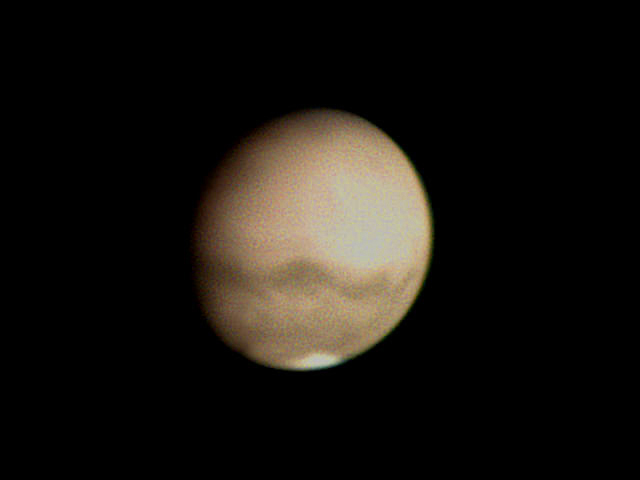
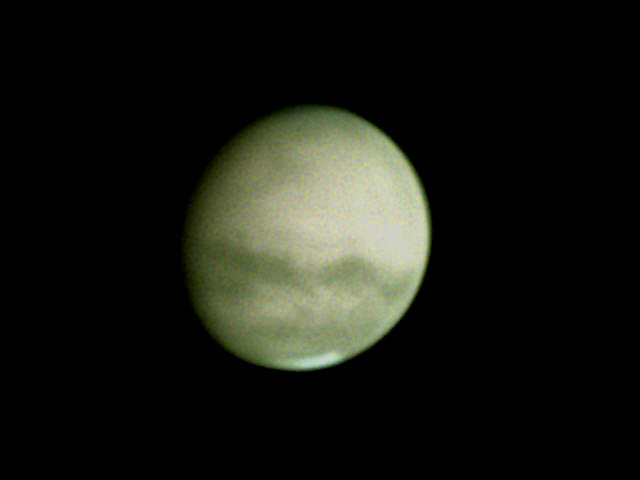
The two pictures immediately above were taken on the evening of September 7, at 6:25 and 8:06 pm. The dust storm was finally abating, and some of the surface features were becoming visible once again. This pair of images also demonstrates the rotation of Mars in 1 hour 41 minutes (equal to 24.6 degrees of longitude), but this time the view is of the opposite side of the planet to the set of three above. As we were now leaving Mars behind, the images are appreciably smaller (the angular diameter of the red planet had fallen to 20 arcseconds). Well past opposition, Mars on September 7 exhibited a phase effect of 92.65 %.
Central meridian: 180º.
Jupiter: Jupiter is found this month close to the west-north-western horizon at 7 pm on April 1. Observations at such a low elevation are always compromised due to atmospheric turbulence and absorption. Jupiter will be 30 arcminutes south of Uranus just after sunset on April 21, and will cross into Taurus on April 28. It will pass though conjunction with the Sun on May 19 and leave the evening sky. It will reappear in the eastern pre-dawn sky in mid-June.
Jupiter as photographed from Nambour on the evening of April 25, 2017. The images were
taken, from left to right, at 9:10, 9:23, 9:49, 10:06 and 10:37 pm. The rapid rotation of this giant planet in a little under 10 hours is clearly seen. In the
southern hemisphere, the Great Red Spot (bigger than the Earth) is prominent, sitting within a 'bay' in the South Tropical Belt. South of it is one of the
numerous White Spots. All of these are features in the cloud tops of Jupiter's atmosphere.
Jupiter at opposition, May 9, 2018

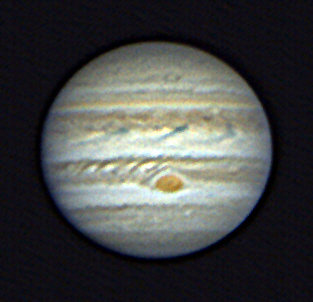

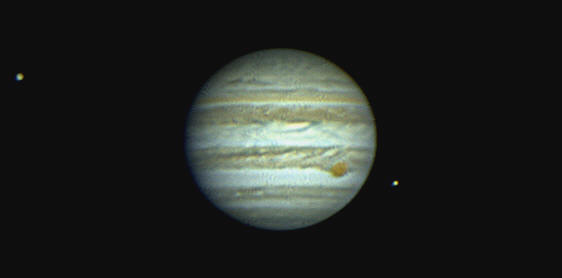
Jupiter as it appeared at 7:29 pm on July 2, 2017. The Great Red Spot was in a similar position near Jupiter's eastern limb (edge) as in the fourth picture in the series above.
It will be seen that in the past two months the position of the Spot had drifted
when compared with the festoons in the Equatorial Belt, so must rotate around the planet at a slower rate. In fact, the Belt enclosing the Great Red Spot rotates around the
planet in 9 hours 55 minutes, and the Equatorial Belt takes five minutes less. This high rate of rotation has made the planet quite oblate. The prominent 'bay'
around the Red Spot in the five earlier images appeared to be disappearing, and a darker streak along the northern edge of the South Tropical Belt
was moving
south. In June this year the Spot began to shrink in size, losing about 20% of its
diameter. Two new white spots have developed in the South Temperate Belt, west of the Red Spot. The five upper images were taken near opposition, when the Sun was
directly behind the Earth and illuminating all of Jupiter's disc evenly. The July 2 image was taken just four days before Eastern Quadrature, when the angle
from the Sun to Jupiter and back to the Earth was at its maximum size. This angle means that we see a tiny amount of Jupiter's dark side, the shadow being
visible around the limb of the planet on the left-hand side, whereas the right-hand limb is clear and sharp. Three of Jupiter's Galilean satellites are visible, Ganymede to
the left and Europa to the right. The satellite Io can be detected in a transit of Jupiter, sitting in front of the North Tropical Belt, just to the left of its centre.
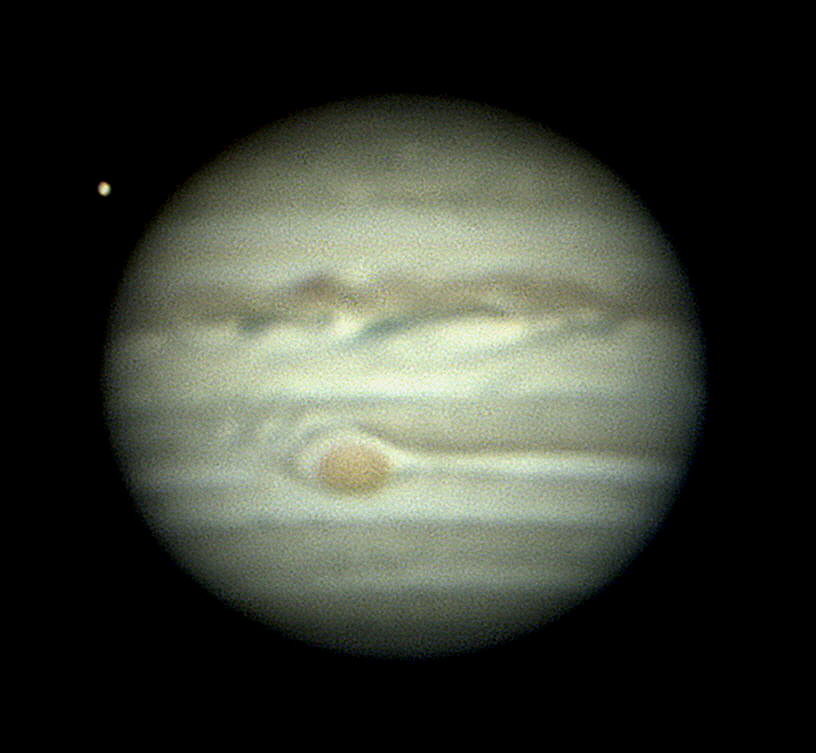
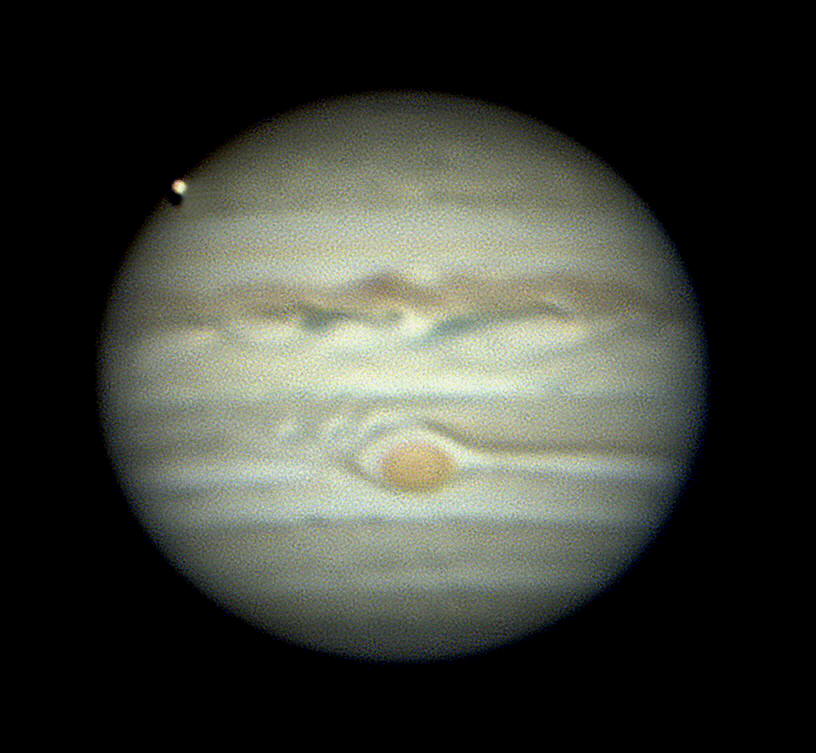
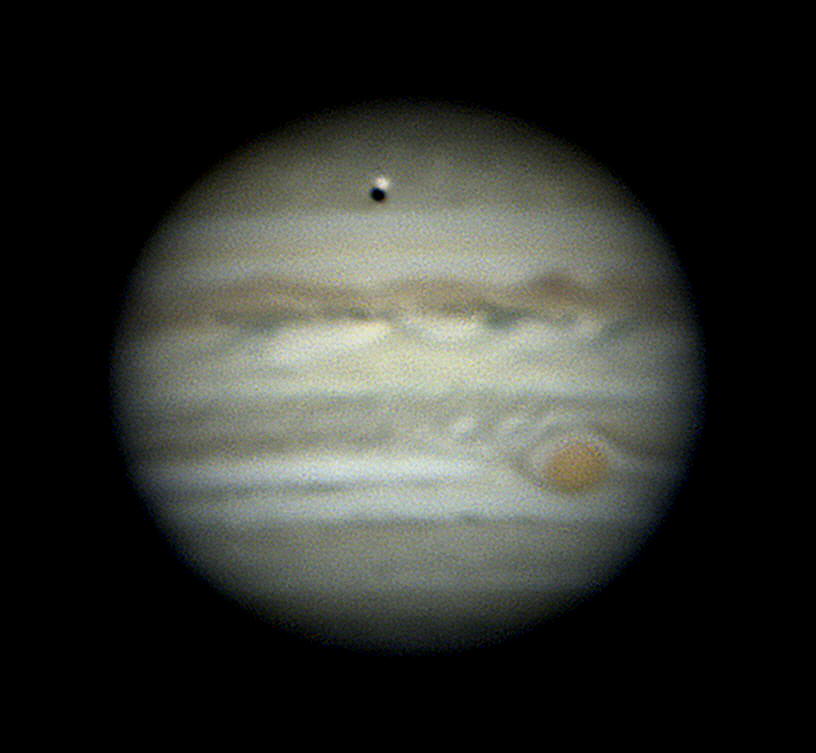
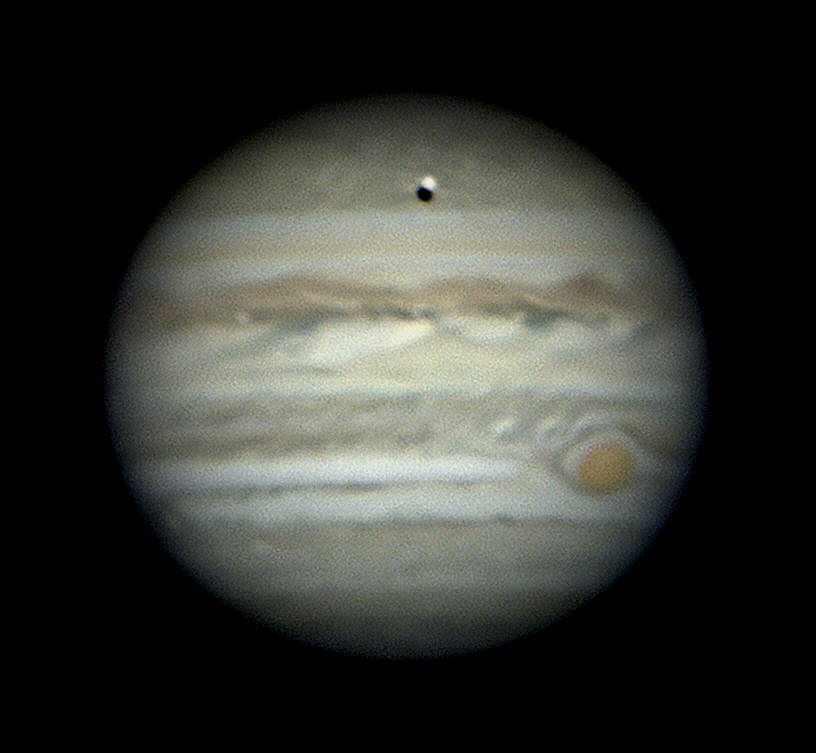
Jupiter reached opposition on May 9, 2018 at 10:21 hrs, and the above photographs were taken that evening, some ten to twelve hours later. The first image above was taken at 9:03 pm, when the Great Red Spot was approaching Jupiter's central meridian and the satellite Europa was preparing to transit Jupiter's disc. Europa's transit began at 9:22 pm, one minute after its shadow had touched Jupiter's cloud tops. The second photograph was taken three minutes later at 9:25 pm, with the Great Red Spot very close to Jupiter's central meridian.
The third photograph was taken at 10:20 pm, when Europa was approaching Jupiter's central meridian. Its dark shadow is behind it, slightly below, on the clouds of the North Temperate Belt. The shadow is partially eclipsed by Europa itself. The fourth photograph at 10:34 pm shows Europa and its shadow well past the central meridian. Europa is the smallest of the Galilean satellites, and has a diameter of 3120 kilometres. It is ice-covered, which accounts for its brightness and whitish colour. Jupiter's elevation above the horizon for the four photographs in order was 50º, 55º, 66º and 71º. As the evening progressed, the air temperature dropped a little and the planet gained altitude. The 'seeing' improved slightly, from Antoniadi IV to Antoniadi III. At the time of the photographs, Europa's angular diameter was 1.57 arcseconds. Part of the final photograph is enlarged below.

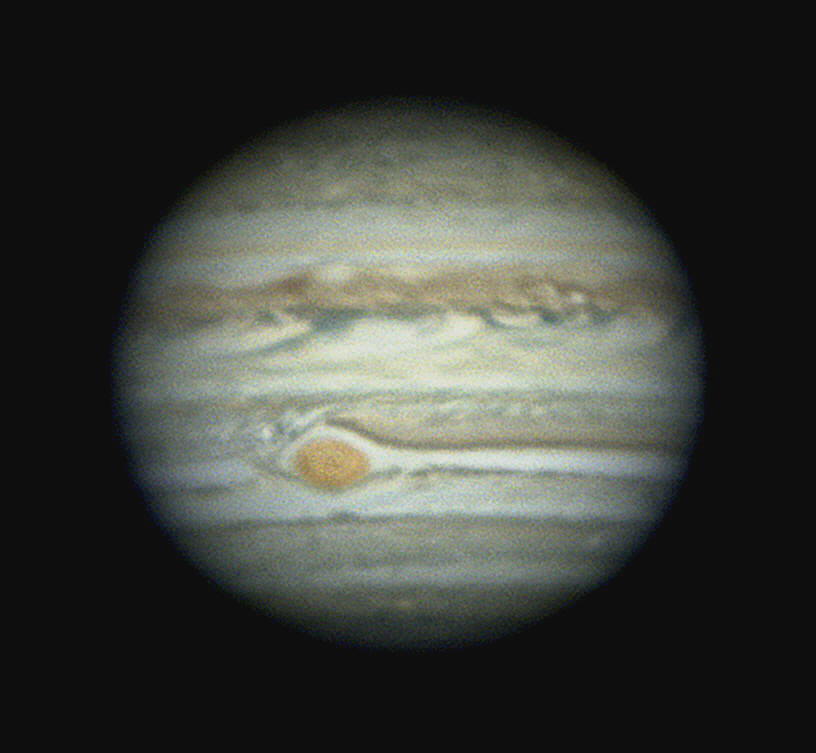
Jupiter at 11:34 pm on May 18, nine days later. Changes in the rotating cloud patterns are apparent, as some cloud bands rotate faster than others and
interact. Compare with the first photograph in the line of four taken on May 9. The Great Red Spot is ploughing a furrow through the clouds of the South
Tropical Belt, and is pushing up a turbulent bow wave.
Jupiter at opposition, June 11, 2019
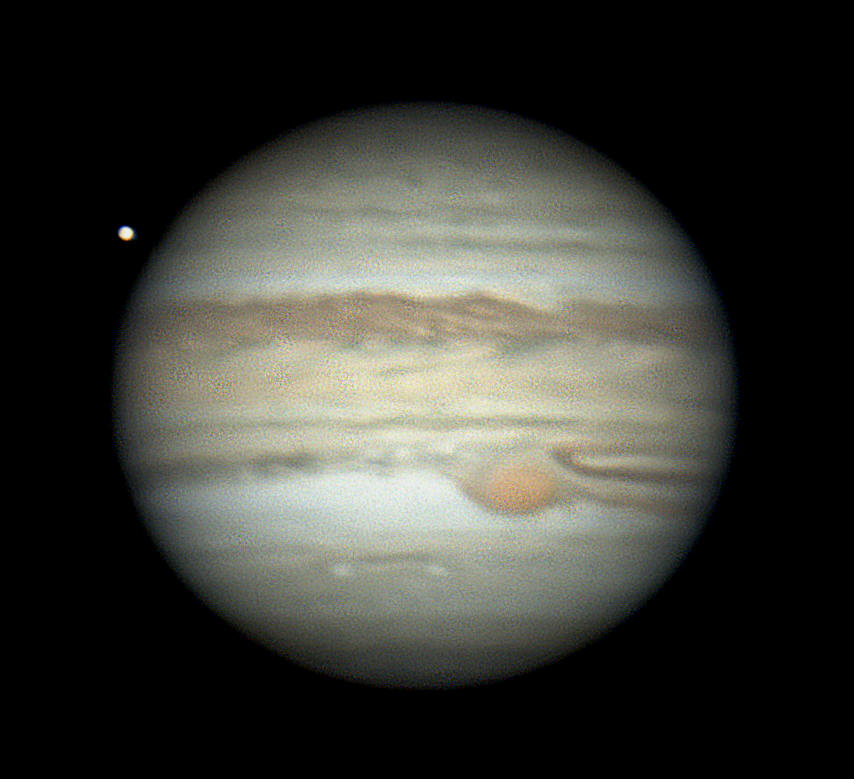
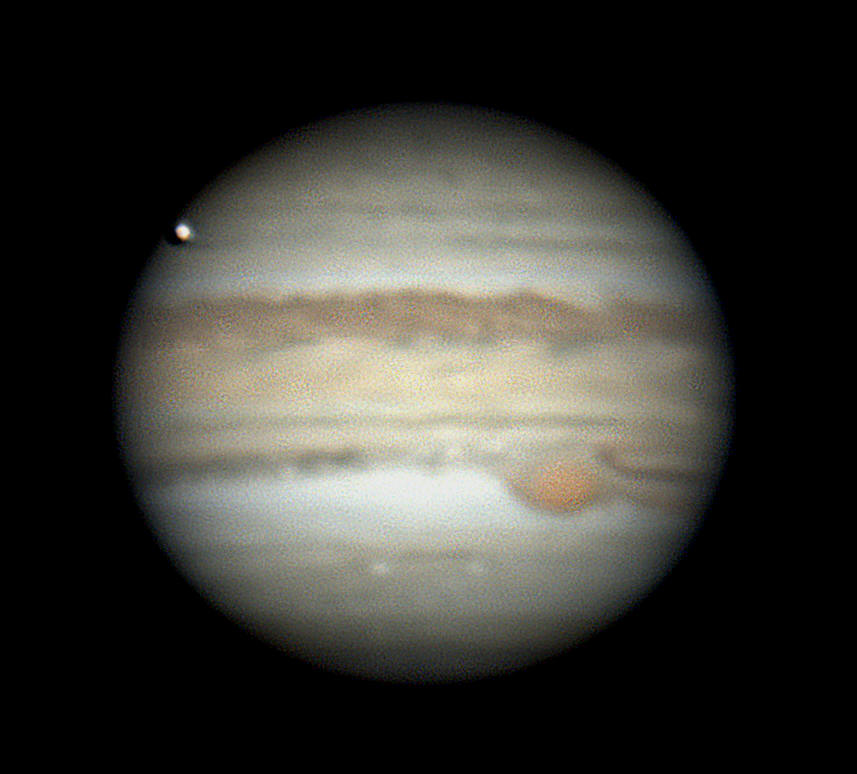
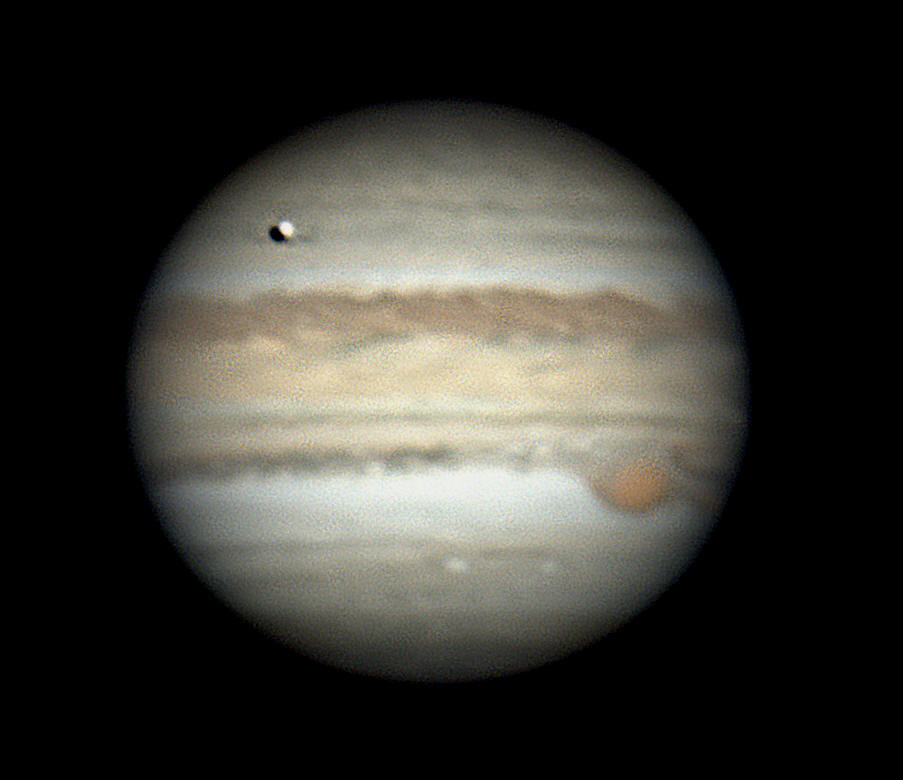

Jupiter reached opposition on June 11, 2019 at 01:20 hrs, and the above photographs were taken that evening, some twenty to twenty-two hours later. The first image above was taken at 10:01 pm, when the Great Red Spot was leaving Jupiter's central meridian and the satellite Europa was preparing to transit Jupiter's disc.
The third photograph was taken at 10:41 pm, when Europa was about a third of its way across Jupiter. Its dark shadow is trailing it, slightly below, on the clouds of the North Temperate Belt. The shadow is partially eclipsed by Europa itself. The fourth photograph at 10:54 pm shows Europa and its shadow about a quarter of the way across. This image is enlarged below. The fifth photograph shows Europa on Jupiter's central meridian at 11:24 pm, with the Great Red Spot on Jupiter's limb. The sixth photograph taken at 11:45 pm shows Europa about two-thirds of the way through its transit, and the Great Red Spot almost out of sight. In this image, the satellite Callisto may be seen to the lower right of its parent planet. Jupiter's elevation above the horizon for the six photographs in order was 66º, 70º, 75º, 78º, 84º and 86º. As the evening progressed, the 'seeing' proved quite variable.
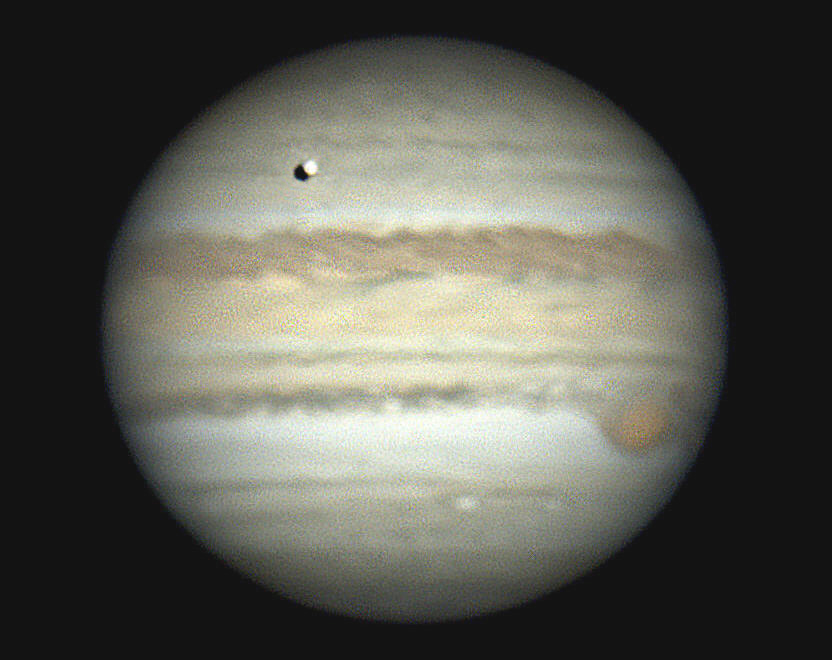
There have been numerous alterations to Jupiter's belts and spots over the thirteen months since the 2018 opposition. In particular, there have been major disturbances affecting the Great Red Spot, which appears to be slowly changing in size or "unravelling". It was very fortuitous that, during the evenings of the days when the 2018 and 2019 oppositions occurred, there was a transit of one of the satellites as well as the appearance of the Great Red Spot. It was also interesting in that the same satellite, Europa, was involved both times.
Jupiter's moon Europa has an icy crust with very high reflectivity, which accounts for its brightness in the images above. On the other hand, the largest
moon Ganymede (seen below) has a surface which is composed of two types of terrain: very old, highly cratered dark regions, and somewhat younger (but still
ancient) lighter regions marked with an extensive array of grooves and ridges. Although there is much ice covering the surface, the dark areas contain clays
and organic materials and cover about one third of the moon. Beneath the surface of Ganymede is believed to be a saltwater ocean with two separate layers.
Jupiter is seen here on 17 November 2022 at 8:39 pm. To its far right is its largest satellite, Ganymede. This "moon"
is smaller than the Earth but is bigger than Earth's Moon. Its diameter is 5268 kilometres, but at Jupiter's distance its angular diameter is only 1.67 arcseconds.
Despite its small size, Ganymede is the biggest moon in the Solar System. Jupiter is approaching eastern quadrature, which means that Ganymede's shadow is not behind it as in the shadows of Europa in the two
sequences taken at opposition. In the instance above as seen from Earth (which is presently at a large angle from a line joining the Sun to Ganymede), the
circular shadow of Ganymede is striking the southern hemisphere cloud tops of Jupiter itself. The shadow is slightly distorted as it strikes the spherical
globe of Jupiter. If there were any inhabitants of Jupiter flying across the cloud bands above, and passing through the black shadow, they would experience
an eclipse of the distant Sun by the moon Ganymede.


Above is a 7X enlargement of Ganymede, showing markings on its rugged, icy surface. The dark area in its northern hemisphere is called Galileo Regio.
Saturn:
The ringed planet is located in the constellation of Aquarius, and will remain there until it crosses into Pisces on April 19, 2025. Saturn reached conjunction with the Sun on February 29 and may be found close to the eastern horizon just before sunrise. As the month progresses, Saturn will move away from the solar glare and will be easier to find.
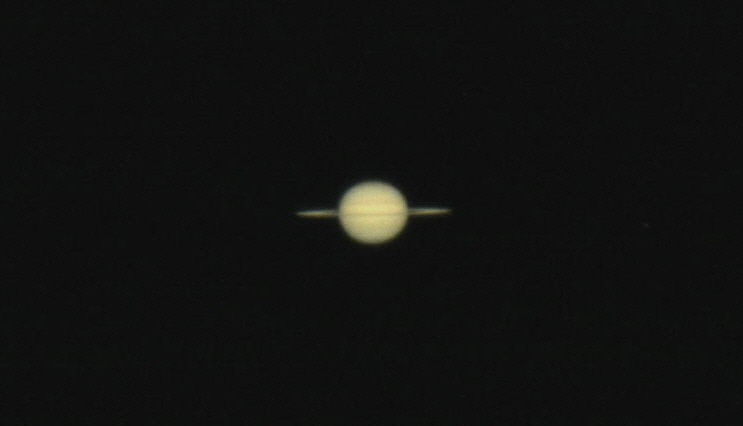
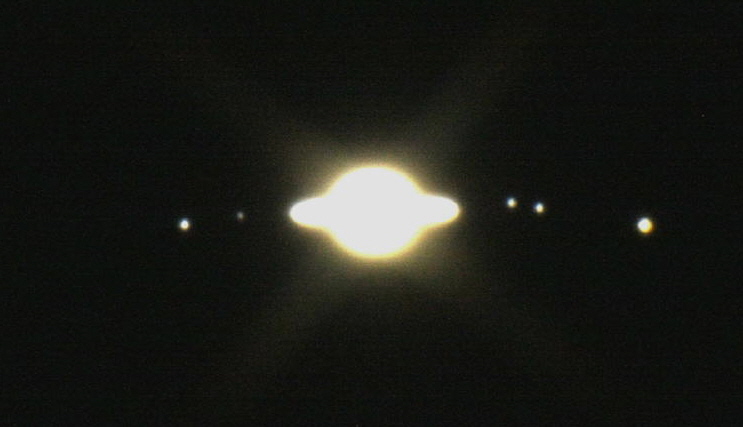
Left: Saturn showing the Rings when edge-on. Right: Over-exposed Saturn surrounded by its satellites Rhea, Enceladus, Dione, Tethys and Titan - February 23/24, 2009.
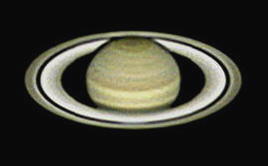
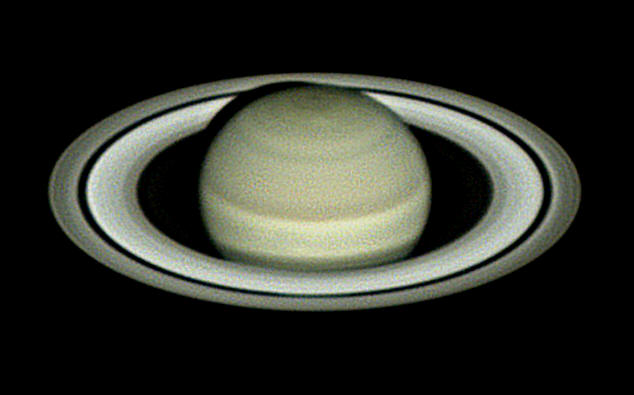
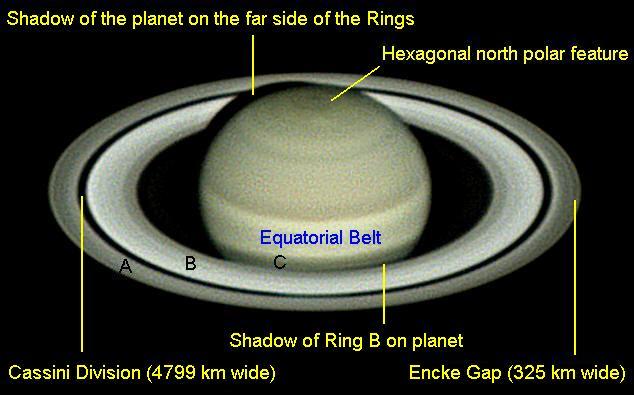
Neptune: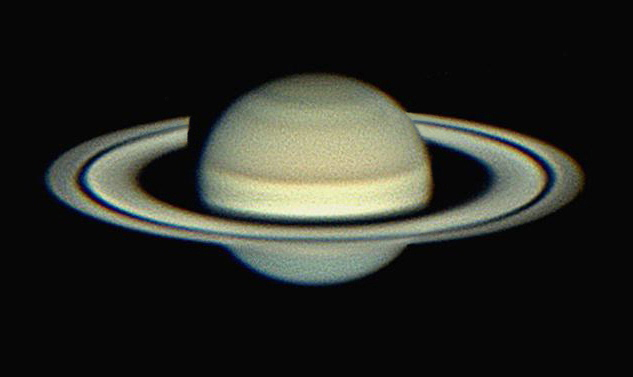
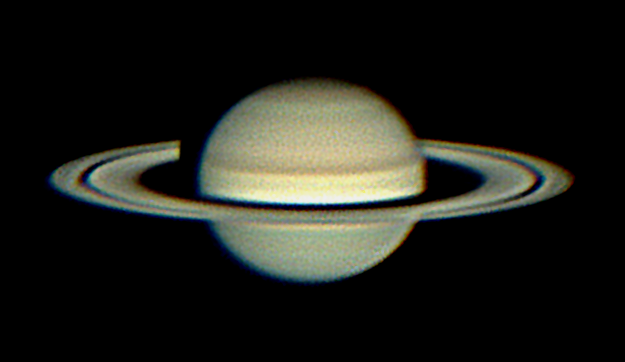
The photograph above was taken at 7:41 pm on December 07, 2023, 14 days after eastern quadrature. The shadow of the planet once more falls across the far side
of the rings, but in the intervening 13 months the angle of the rings as seen from Earth has lessened considerably. The light-coloured equatorial zone on
Saturn shows through the gap known as the Cassini Division.
The change in aspect of Saturn's rings is caused by the plane of the ring system being aligned with Saturn's equator, which is itself tilted at an angle of 26.7 degrees to Saturn's orbit.
As the Earth's orbit around the Sun is in much the same plane as Saturn's, and
the rings are always tilted in the same direction in space, as we both orbit the Sun, observers on Earth see the configuration of the rings change from wide open (top large picture) to half-open
(bottom large picture) and finally to edge on (small picture above). This cycle is due to Saturn taking 29.457 years to complete an orbit of the Sun, so the
complete cycle from
"edge-on (2009) →
view of Northern hemisphere, rings half-open (2013) → wide-open (2017) → half-open (2022) →
Uranus:

Neptune, photographed from Nambour on October 31, 2008
Pluto: The erstwhile ninth and most distant planet
will pass through w
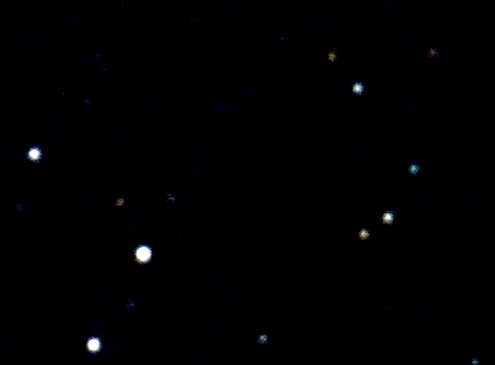
The movement of the dwarf planet Pluto in two days, between 13 and 15 September, 2008. Pluto is the one object that has moved.
Width of field: 200 arcseconds

This is a stack of four images, showing the movement of Pluto over the period October 22 to 25, 2014. Pluto's image for each date appears as a star-like point at the upper right corner of the numerals. The four are equidistant points on an almost-straight line. Four eleventh magnitude field stars are identified. A is GSC 6292:20, mv = 11.6. B is GSC 6288:1587, mv = 11.9. C is GSC 6292:171, mv = 11.2.
D is GSC 6292:36, mv = 11.5. (GSC = Guide Star Catalogue). The position of Pluto on October 24 (centre of image) was at Right Ascension = 18 hours 48 minutes 13 seconds, Declination = -20º 39' 11". The planet moved 2' 51" with respect to the stellar background during the three days between the first and last images, or 57 arcseconds per day, or 1 arcsecond every 25¼ minutes.
Meteor Showers:
Pi Puppids
April 24 Full
Moon, 99% sunlit ZHR = 10
Radiant: Between the False Cross and the tail of Canis Major
U
Although most meteors are found in swarms associated with debris from comets, there are numerous 'loners', meteors travelling on solitary
paths through space. When these enter our atmosphere, unannounced and at any time, they are known as 'sporadics'. On an average clear and dark evening, an
observer can expect to see about ten meteors per hour. They burn up to ash in their passage through our atmosphere. The ash slowly settles to the ground as
meteoric dust. The Earth gains about 80 tonnes of such dust every day, so a percentage of the soil we walk on is actually interplanetary in origin. If a
meteor survives its passage through the air and reaches the ground, it is called a 'meteorite'. In the past, large meteorites (possibly comet nuclei or small asteroids) collided with the Earth and produced huge craters which still exist
today. These craters are called 'astroblemes'. Two famous ones in Australia are Wolfe Creek Crater and Gosse's Bluff. The Moon and Mercury are covered with such
astroblemes, and craters are also found on Venus, Mars, planetary satellites, minor planets, asteroids and even comets.
Comets:
ZHR = zenithal hourly rate (number of meteors expected to be observed at the zenith in one hour). The
maximum phase of meteor showers usually occurs between 3 am and sunrise. The reason most meteors are observed in the pre-dawn hours is because at that time
we are on the front of the Earth as it rushes through space at 107 000 km per hour (30 km per second). We are meeting the meteors head-on, and the speed at
which they enter our atmosphere is the sum of their own speed plus ours. In the evenings, we are on the rear side of the Earth, and many meteors we see at that
time are actually having to catch us up. This means that the speed at which they enter our atmosphere is less than in the morning hours, and they burn up less
brilliantly.
This periodic comet returns every 71 years, and is in our western twilight sky at present. Look due west, close to the horizon as soon as the sky darkens. During the month, the comet will move south-east towards the star Rigel in Orion, but will be getting closer to the Sun each night. For more information, click
A potentially great comet is currently moving sunward, promising a spectacular show later this year. That comet, C/2023 A3 (Tsuchinshan-ATLAS), was discovered in
January 2023, and astronomers soon realised it has the potential to become truly dazzling. Current predictions suggest Tsuchinshan-ATLAS will be at least as bright as the brightest stars in late September and early October this year. During that time, it will
pass almost directly between Earth and the Sun. It might even briefly become visible in broad daylight at that time. In the days following that chance alignment, the comet will gradually become visible in the evening sky and could be an incredible sight, up to
a hundred times brighter than Pons–Brooks at its best. For more information, click
Green Comet ZTF (C/2022 E3)
This comet was discovered on 2 March 2022 at the Zwicky Transient Facility (ZTF) at the Hale Observatory on Mount Palomar. It was found on CCD images taken by the
famous 48-inch Schmidt Telescope. It
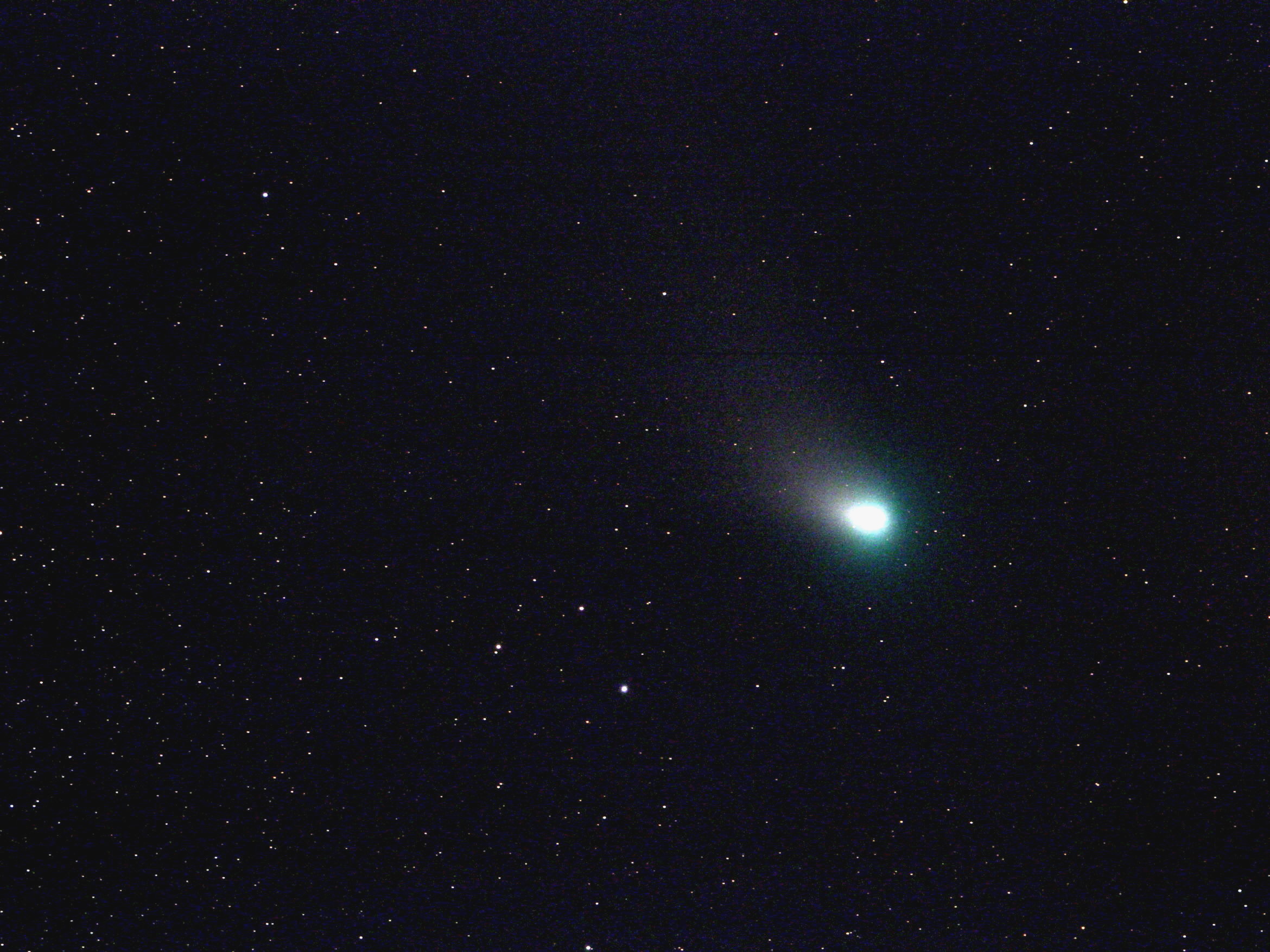
Comet ZTF (C/2022 E3), photographed from Nambour at 9 pm on February 11, 2023.

Both of these comets appeared recently in orbits that caused them to dive towards the Sun's surface before swinging around the Sun and heading back towards the far reaches of the Solar System. Such comets are called 'Sun grazers', and their close approach to the Sun takes them through its immensely powerful gravitational field and the hot outer atmosphere called the 'corona'. They brighten considerably during their approach, but most do not survive and disintegrate as the ice which holds them together melts. While expectations were high that these two would emerge from their encounter and put on a display as bright comets with long tails when they left the Sun, as they came close to the Sun they both broke up into small fragments of rock and ice and ceased to exist.
Comet 46P/Wirtanen
In December 2018, Comet 46P/Wirtanen swept past Earth, making one of the ten closest approaches of a comet to our planet since 1960. It was faintly visible to the naked eye for two weeks. Although Wirtanen's nucleus is only 1.2 kilometres across, its green atmosphere became larger than the Full Moon, and was an easy target for binoculars and small telescopes. It reached its closest to the Sun (perihelion) on December 12, and then headed in our direction. It passed the Earth at a distance of 11.5 million kilometres (30 times as far away as the Moon) on December 16, 2018.
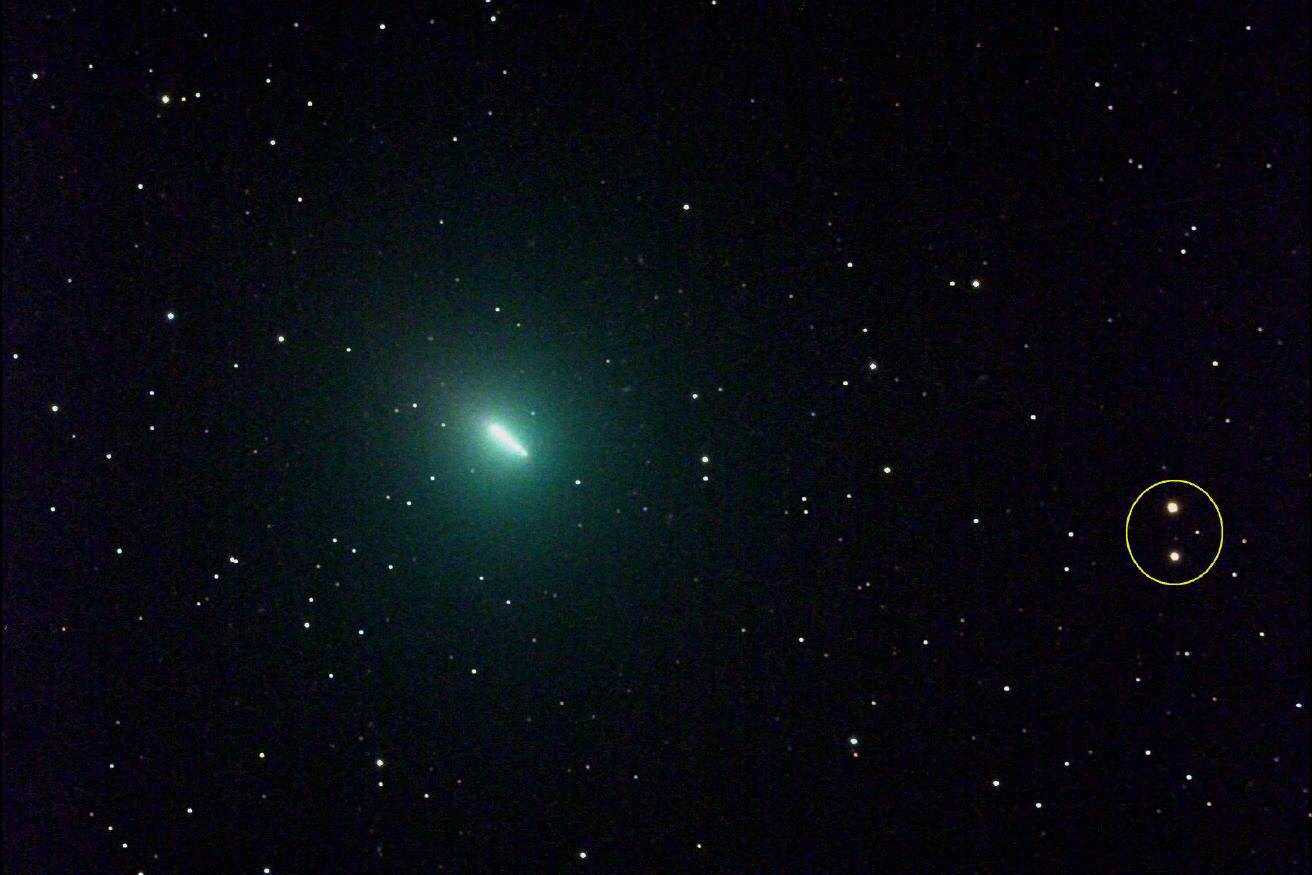
Comet Lulin
This comet, (C/2007 N3), discovered
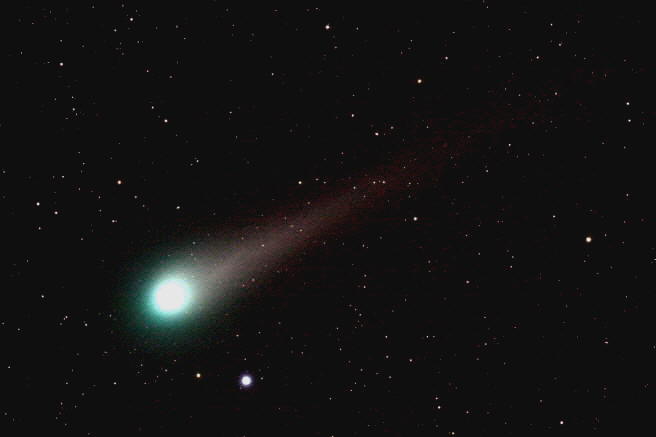
Comet Lulin at 11:25 pm on February 28, 2009, in Leo. The brightest star is Nu Leonis, magnitude 5.26.
The
LINEARNearly all of these programs are based in the northern hemisphere, leaving gaps in the coverage of the southern sky. These gaps are the areas of sky where amateur astronomers look for comets from their backyard observatories.
To find out more about current comets, including finder charts showing exact positions and magnitudes, click
here. To see pictures of these comets, click here.
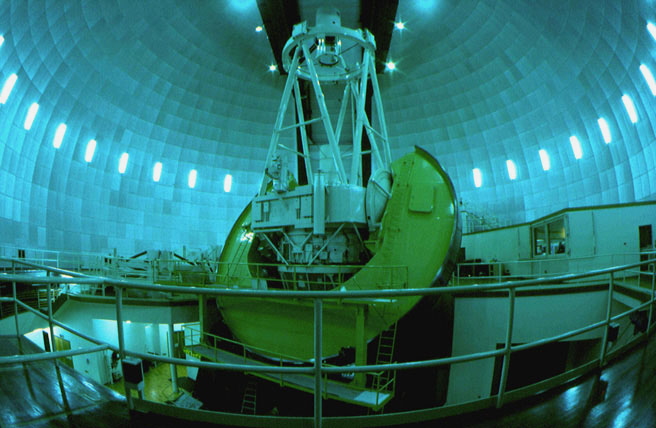
The 3.9 metre Anglo-Australian Telescope (AAT) at the Australian Astronomical Observatory near Coonabarabran, NSW.
Deep Space
Sky Charts and Maps available on-line:
There are some useful representations of the sky available here. The sky charts linked
below show the sky as it appears to the unaided eye. Stars rise four minutes earlier each night, so at the end of a week the stars have gained about half an
hour. After a month they have gained two hours. In other words, the stars that were positioned in the sky at 8 pm at the beginning of a month will have the
same positions at 6 pm by the end of that month. After 12 months the stars have gained 12 x 2 hours = 24 hours = 1 day, so after a year the stars have returned
to their original positions for the chosen time. This accounts for the slow changing of the starry sky as the seasons progress.
The following interactive sky charts are courtesy of Sky and Telescope magazine. They can simulate a view of the sky from any location on Earth at any time of day or night between the years 1600 and 2400. You can also print an all-sky map. A Java-enabled web browser is required. You will need to specify the location, date and time before the charts are generated. The accuracy of the charts will depend on your computer’s clock being set to the correct time and date.
To produce a real-time sky chart (i.e. a chart showing the sky at the instant the chart is generated), enter the name of your nearest city and the country. You will also need to enter the approximate latitude and longitude of your observing site. For the Sunshine Coast, these are:
latitude: 26.6o South longitude: 153o East
Then enter your time, by scrolling down through the list of cities to "Brisbane: UT + 10 hours". Enter this one if you are located near this city, as Nambour is. The code means that Brisbane is ten hours ahead of Universal Time (UT), which is related to Greenwich Mean Time (GMT), the time observed at longitude 0o, which passes through London, England. Click here to generate these charts.
_____________________________________
Similar real-time charts can also be generated from another source, by following this second link:
The first, circular chart will show the full hemisphere of sky overhead. The zenith is at the centre of the circle, and the cardinal points are shown around the circumference, which marks the horizon. The chart also shows the positions of the Moon and planets at that time. As the chart is rather cluttered, click on a part of it to show that section of the sky in greater detail. Also, click on Update to make the screen concurrent with the ever-moving sky.
The stars and constellations around the horizon to an elevation of about 40o can be examined by clicking on
The view can be panned around the horizon, 45 degrees at a time. Scrolling down the screen will reveal tables showing setup and customising options, and an Ephemeris showing the positions of the Sun, Moon and planets, and whether they are visible at the time or not. These charts and data are from YourSky, produced by John Walker.
The charts above and the descriptions below assume that the observer has a good observing site with a low, flat horizon that is not too much obscured by buildings or trees. Detection of fainter sky objects is greatly assisted if the observer can avoid bright lights, or, ideally, travel to a dark sky site. On the Sunshine Coast, one merely has to travel a few kilometres west of the coastal strip to enjoy magnificent sky views. On the Blackall Range, simply avoid streetlights. Allow your eyes about 15 minutes to become dark-adapted, a little longer if you have been watching television. Small binoculars can provide some amazing views, and with a small telescope, the sky’s the limit.
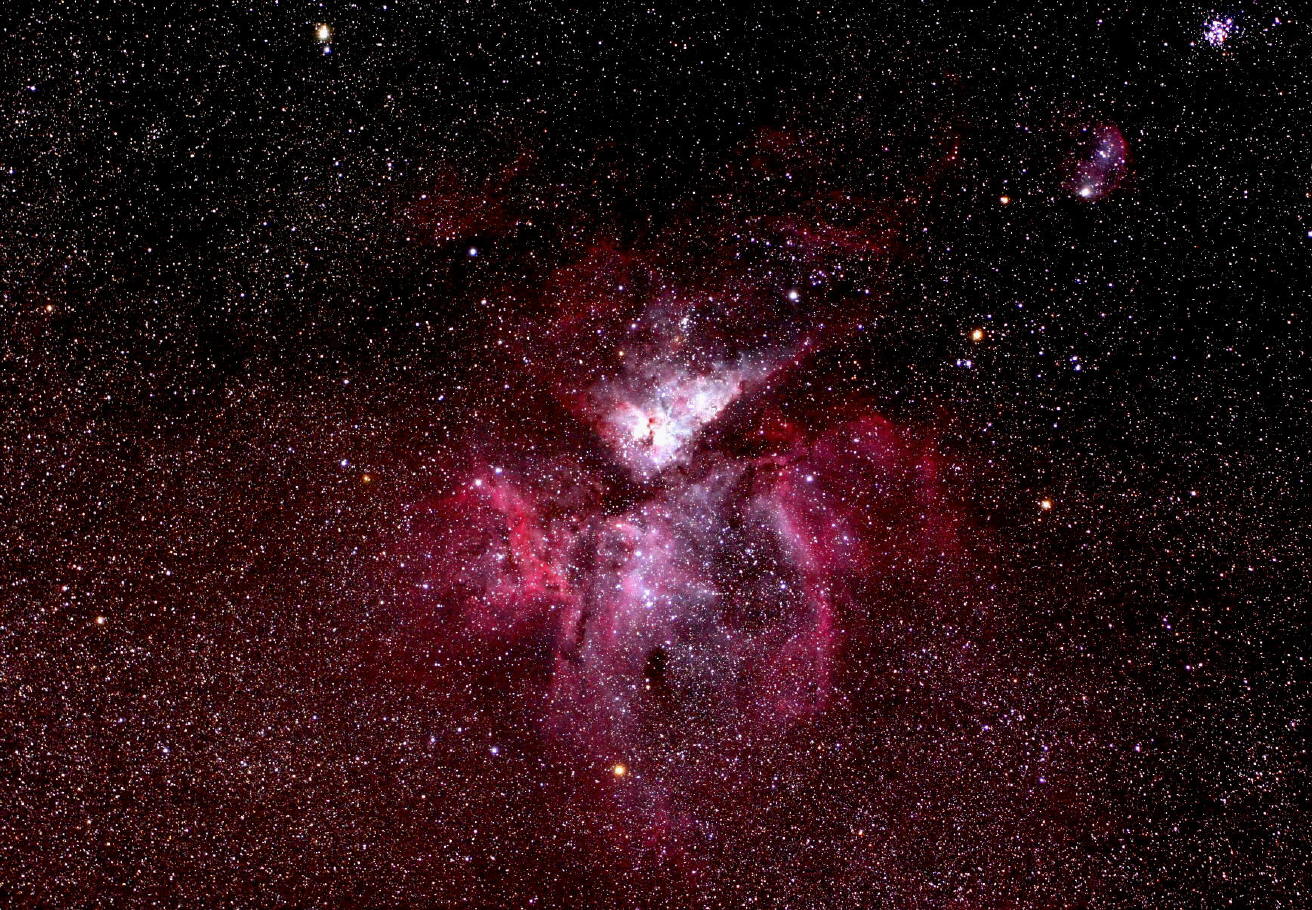
This month,
The Stars and Constellations for this
This description of the night sky is for 9 pm on April 1 and 7 pm on April 30. It starts at Orion, which is low in the west. No naked-eye planets are available in the evenings this month.


The constellation Taurus the Bull is straddling the west-north-westerly horizon, but its main features, the
Pleiades and Hyades clusters, will have set by
8:30 pm on April 1. The brightest star in Taurus is a star dominating (but not actually a member of) the Hyades cluster. This is
Aldebaran, a K5 orange star with a visual
magnitude of 0.87. It is only half as far away as the Hyades. The Pleiades will have disappeared by
7 pm at mid-month, and the rest of Taurus follows them below the horizon soon after.
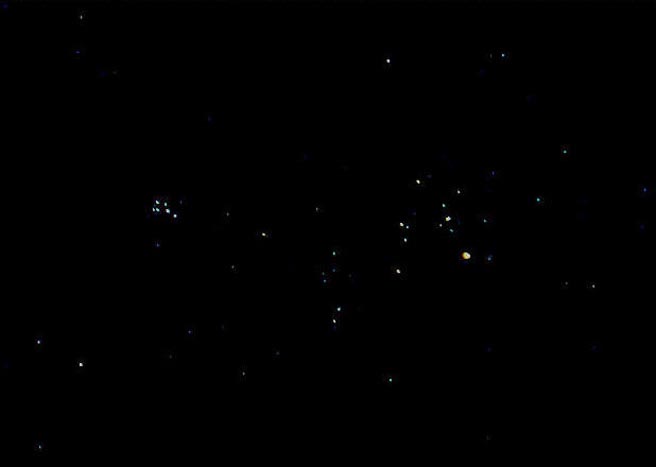
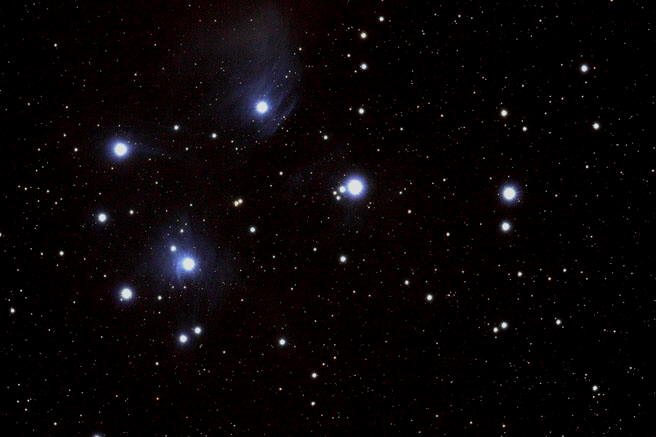
Wisps of the nebula which formed the Pleiades can be seen around the brighter stars in the cluster.
Above the north-western horizon lies the constellation of Gemini, the Twins. The two twin stars at its north-eastern end, Pollux and Castor,
are very distinctive, Pollux being vertically above Castor. These two stars are about one handspan
above the horizon, but will have set by 10.30 pm at mid-month. Directly above Pollux and Castor, is the first magnitude star Procyon, which is the brightest star in the constellation Canis
Minor (the Small Dog).
High in the north-north-east is another zodiacal constellation, Leo, the Lion. The bright star Regulus (Alpha Leonis) marks the Lion’s heart, and is almost due north. Denebola, the star marking the lion's tail, is high in the north-east. We see the lion upside-down from the Southern Hemisphere. Regulus is the highest star in a pattern called 'The Sickle' (or reaping-hook). It marks the top of the Sickle's handle, with the other end of the handle, the star Eta Leonis, directly underneath. The blade of the Sickle curves around clockwise from Eta Leonis. The Sickle looks like an upside-down question mark, and forms the mane and head of the lion.
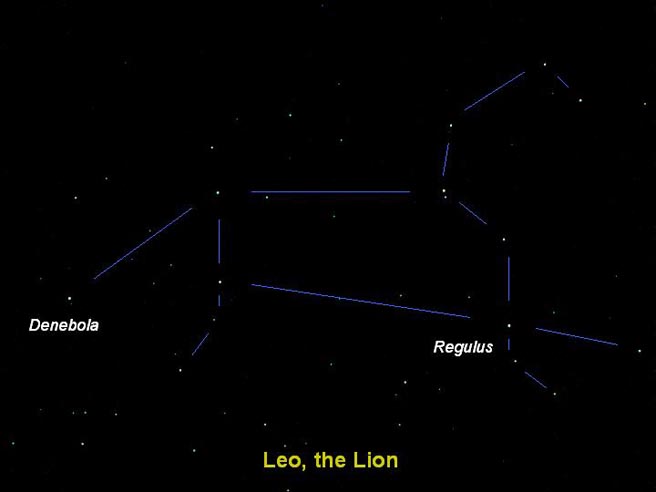
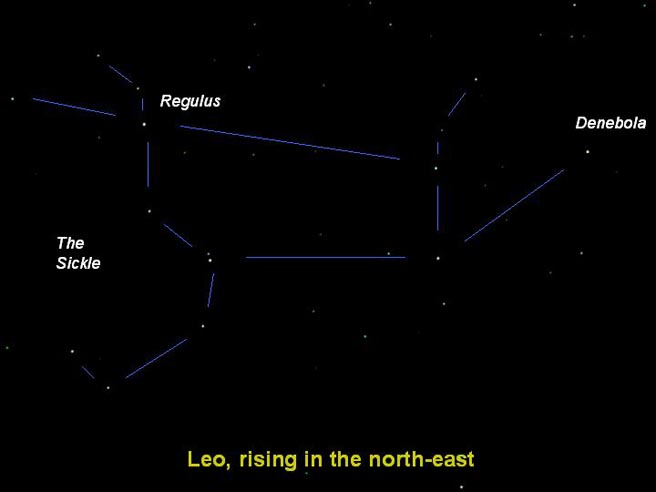
About four degrees to the right and below Eta Leonis is a beautiful double star, Algieba or Gamma Leonis. With a total magnitude of 2.61, the two
stars are only 4.3 arcseconds apart, and may be distinguished with a small telescope. Both are orange in colour.
Between Gemini and Leo is the faint constellation of Cancer the Crab. Though a fairly unremarkable constellation in other ways, Cancer does contain a large star cluster called Praesepe or the Beehive, which is a good sight in binoculars.
Rising in the north-east is a particularly beautiful orange star with a fine name: Arcturus. This is the fourth brightest star (after Sirius, Canopus and Alpha Centauri). It is a K2 star of magnitude -0.06, and lies at a distance of 36 light years. It is the brightest star in the constellation Boötes the Herdsman (only partially risen) and therefore has the alternative name of Alpha Boötis.
High above the eastern horizon (about 45 degrees up) is the next zodiacal constellation after Leo, Virgo, the Virgin. The brightest star in Virgo is Spica, an ellipsoidal variable star whose brightness averages magnitude 1. This makes it the sixteenth brightest star, and its colour is blue-white.
Below Spica and to its right is the faint constellation of Libra (the Scales). It has only two main stars, both about magnitude 2.7, but they have wonderful names: Zuben Elgenubi and Zuben Eschamali. Libra is low in the east, and as the night progresses it will be followed above the horizon by one of the brightest and most easily-recognisable constellations, Scorpius the Scorpion, which will be described next month.
Above Spica and approaching the zenith is the constellation Corvus the Crow, shaped like a quadrilateral of third magnitude stars. A
large but faint constellation, Hydra (the Water-snake), winds its way from near Procyon through the zenith and over the top of Corvus and Virgo to
Libra, which has just risen above the eastern horizon. Hydra has one bright star, Alphard, mv=2.2. Alphard is an orange star that was
known by Arabs in ancient times as 'The Solitary One', as it lies in an area of sky with no bright stars nearby. Tonight it is about 20 degrees north of the
zenith, near culmination. About a handspan to the south-east of Alphard is a bright planetary nebula, the 'Ghost of Jupiter' NGC 3242. It is the
remnant left when the central star exploded (below).
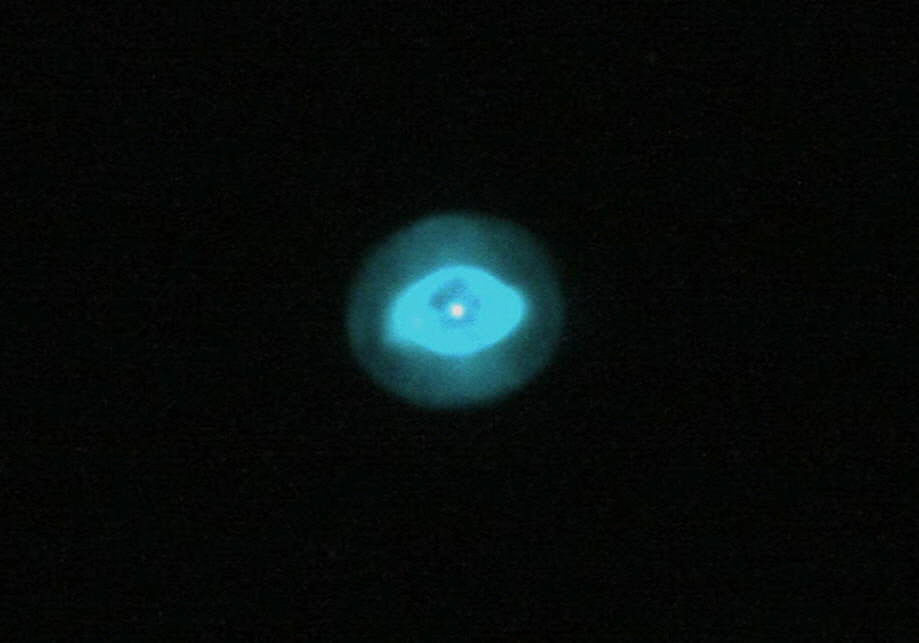
Well up in the south-south-east, Crux (Southern
Cross) is at an angle of about thirty degrees. Just below the second
brightest star in the Cross (Beta Crucis) is a brilliant small star
cluster known as Herschel's Jewel Box. In the centre of the cluster is a
red supergiant star, which is just passing through.
Between Hydra and Leo is a faint constellation, Sextans, (The Sextant),
named by Johannes Hevelius to commemorate his favourite observing instrument
which was destroyed when his observatory was burned by arsonists. Between
Sextans and Corvus is another faint constellation,
Crater, (The Cup). Appearing above the east-south-eastern
horizon is the head of Scorpius, the Scorpion. This
famous zodiacal constellation will be fully risen by 10.00 pm at the beginning
of the month.
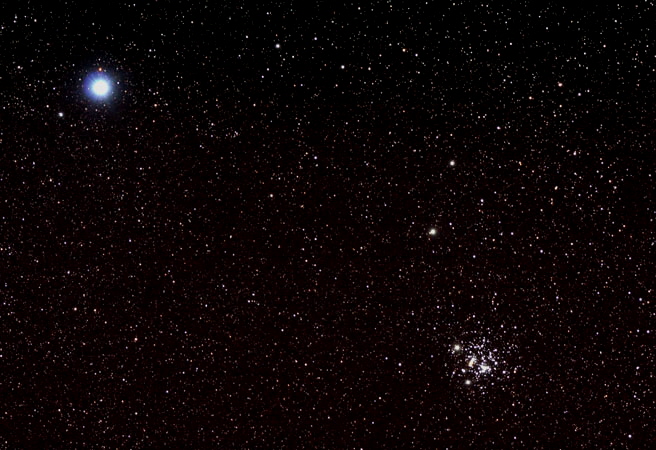

The two Pointers - Alpha
and Beta Centauri - lie below Crux, Alpha being below Beta. Crux will
have rotated clockwise to a vertical position by 11.00 pm at mid-month.
Surrounding Crux on three sides is the large constellation Centaurus, and the
Pointers are its two brightest stars. They are also
known as the Guardians of the Cross.

At top right - the Eta Carinae Nebula. Centre - Crux (Southern Cross) tilted on its side. Beneath Crux - the Coalsack. Bottom - the two Pointers, Alpha and Beta Centauri.
To the right and below Crux is a small, fainter quadrilateral of stars,
Musca, the Fly. Out of all the 88 constellations, it is the only insect.
Below Alpha Centauri is a (roughly) equilateral triangle of 3rd magnitude stars.
This is the constellation
Triangulum Australe, the Southern Triangle. It is well above the
south-south-eastern horizon.
Between Crux and Sirius is a very large area of sky filled with interesting objects. This was once the huge constellation Argo Navis, named for Jason’s famous ship used by the Argonauts in their quest for the Golden Fleece. The constellation Argo was found to be too large, so in the eighteenth century Nicholas Lacaille divided it into three sections - Carina (the Keel), Vela (the Sails) and Puppis (the Stern).
One and a half handspans south of Sirius is the second brightest star in the night sky, Canopus (Alpha Carinae). Although appearing almost as bright as Sirius but a little more yellow, the two stars are entirely dissimilar. Sirius is a normal-sized star that is bright because it is close to us - only 8.6 light years away. Canopus, on the other hand, is a F0 type supergiant, over 100 times brighter than Sirius, but 36 times further away (312 light years).
On the border of Carina and Vela is the False Cross, larger and more lopsided than the Southern Cross. The False Cross is two handspans above Crux and to the right, and is also tilted to the left at this time of year. It has passed culmination, and is beginning to head for the south-south-western horizon. Both of these Crosses are actually more like kites in shape, for, unlike Cygnus (the Northern Cross) they have no star at the intersection of the two cross arms.
Between the Southern Cross and the False Cross may be seen a
glowing patch of light. This is the famous
Eta Carinae Nebula, which is a remarkable sight through binoculars or a
small telescope working at low magnification. It is a turbulent area of dark
dust lanes and fluorescing gas. There is a peculiar unstable star in its centre.
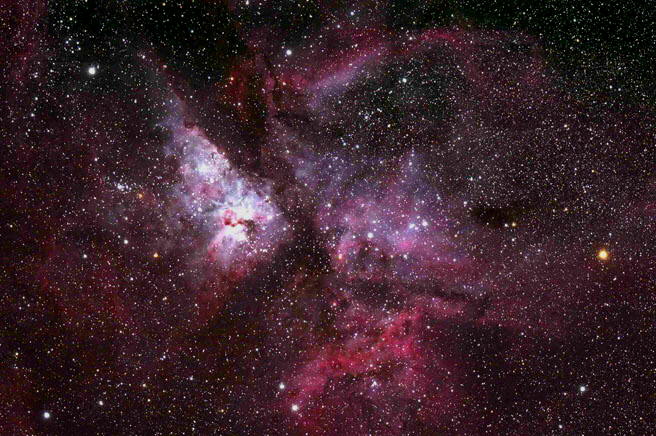
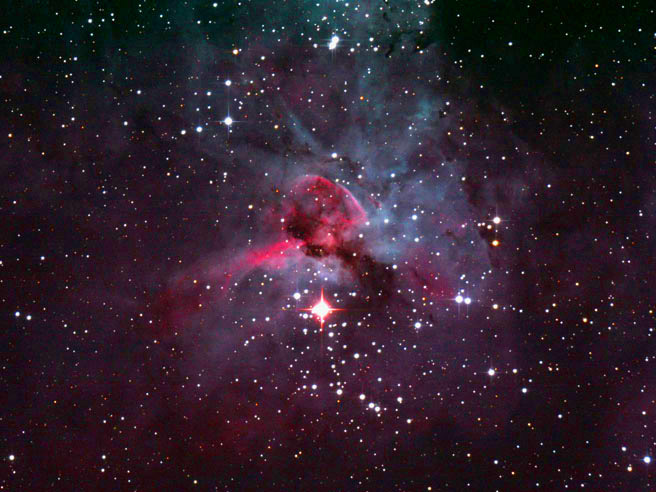
The Keyhole, a dark cloud obscuring part of the Eta Carinae Nebula
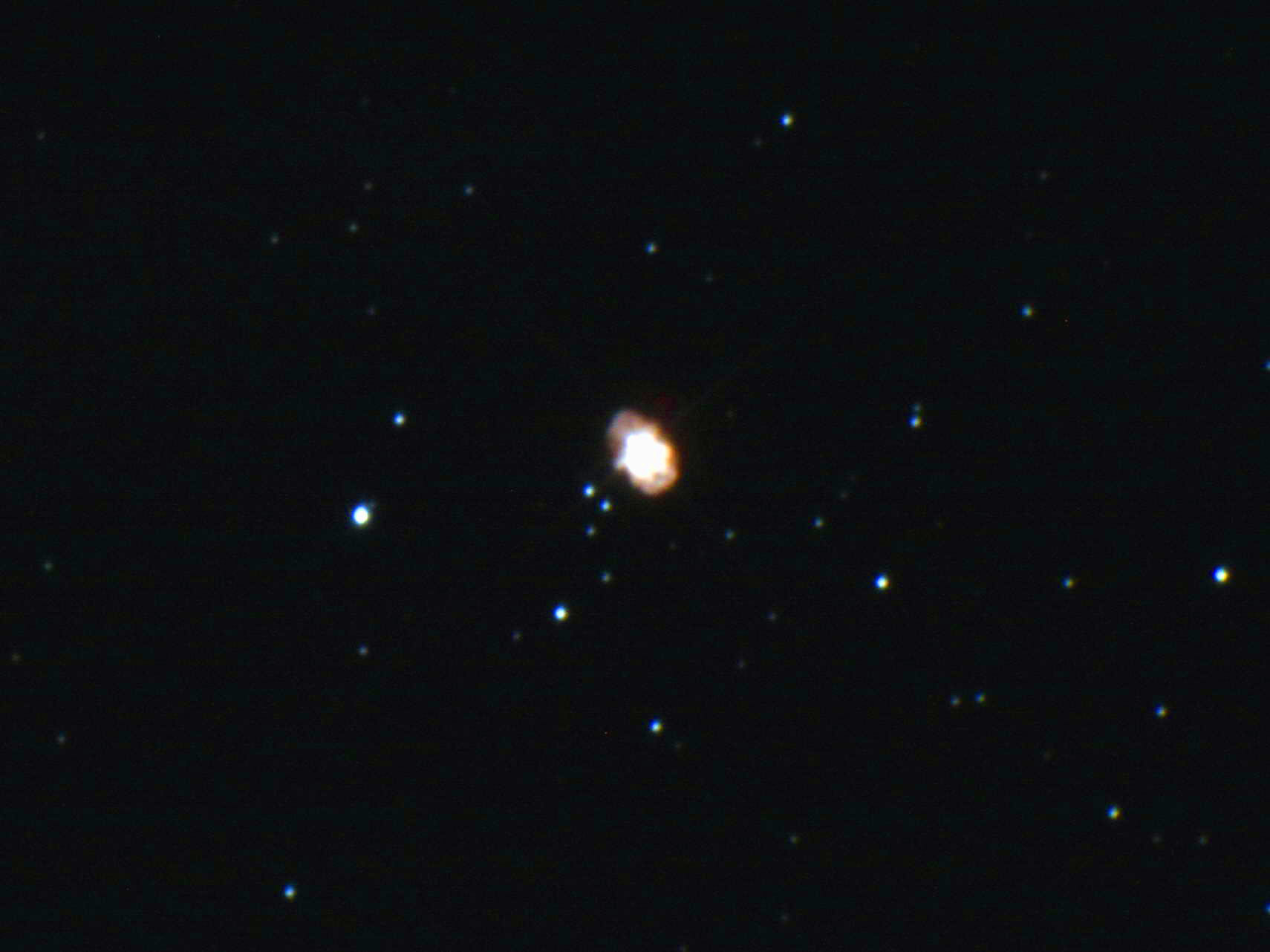
The Homunculus, a tiny planetary nebula ejected by the eruptive variable star, Eta Carinae
Close to the south-south-western horizon is
Achernar, Alpha Eridani. It is the brightest star in Eridanus the
River, which winds its way with faint stars from Achernar in a northerly
direction to Cursa, a mv= 2.9 star close to brilliant Rigel in Orion.
At magnitude 0.49, Achernar is the ninth brightest star. It will have set by
9.00 pm at mid-month.
High in the south, about 30 degrees above the horizon, the Large Magellanic Cloud (LMC) is faintly visible as a diffuse glowing patch. It is about a handspan below (south of) Canopus. About a handspan below and to the left of the LMC is the Small Magellanic Cloud (SMC), a smaller glowing patch. The LMC and SMC are the closest other galaxies to our own Milky Way Galaxy, and are described below.
The zodiacal constellations visible tonight, starting at the west-north-western horizon and heading east (passing about two handspans north of the zenith, are Taurus, Gemini, Cancer, Leo, Virgo and Libra.
Two of the most spectacular constellations in the sky may be seen in the western half of the sky as soon as darkness falls. These are Orion the Hunter, and his large dog, Canis Major. Orion straddles the celestial equator, midway between the south celestial pole and its northern equivalent. This means that the centre of the constellation, the three stars known as Orion's Belt, rise due east and set due west.
This is one of the most easily recognised constellations, as it really does give a very good impression of a human figure. From the northern hemisphere he appears to stand upright when he is high in the sky, but from our location ‘down under’ he appears lying down when rising and setting, and upside down when high in the sky. You can, though, make him appear upright when high in the sky (near the meridian), by observing him from a reclining chair, with your feet pointing to the south and your head tilted back.
.
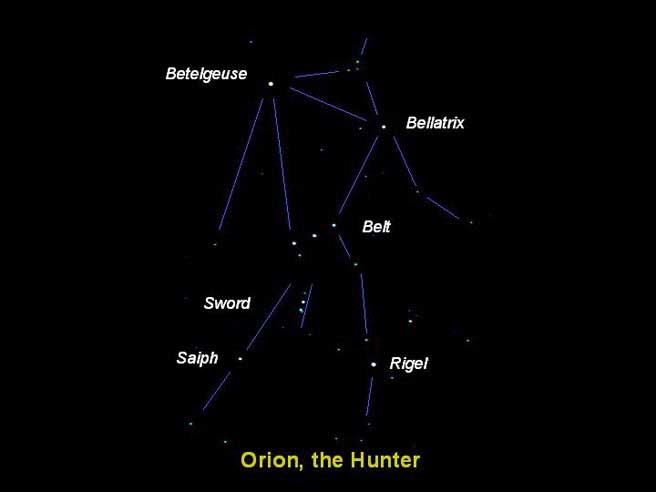
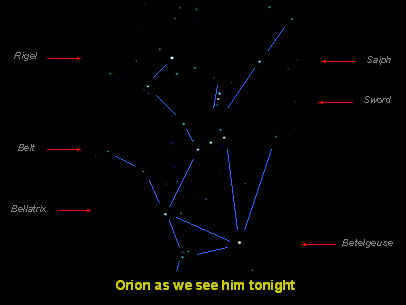
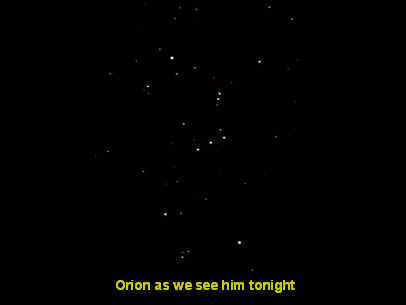
Orion has two bright stars marking his shoulders, the red supergiant
Betelgeuse and Bellatrix. A little north of a line joining these
stars is a tiny triangle of stars marking Orion’s head. The three stars forming
his Belt are, from west to east, Mintaka, Alnilam and Alnitak.
These three stars are related, and all lie at a distance of 1300 light years.
They are members of a group of hot blue-white stars called the Orion
Association.
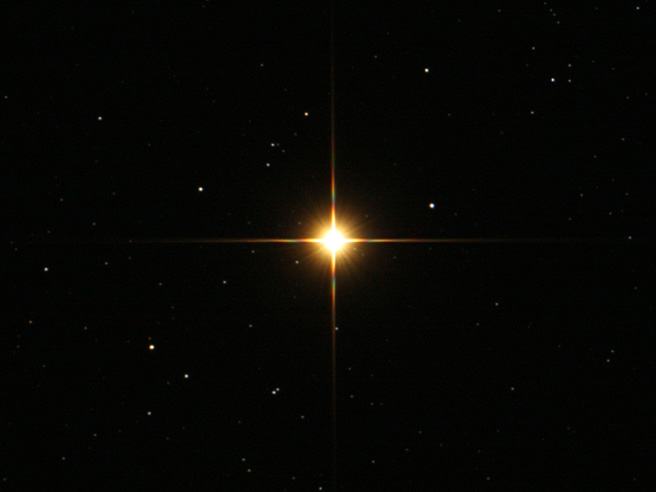
The brilliant white star
Rigel (Beta Orionis).

To the south of the Belt, at a distance of about one Belt-length, we see another faint group of stars in a line, fainter and closer together than those in the
Belt. This is Orion’s Sword. Orion’s two feet are marked by brilliant Rigel and fainter
Saiph. Both of these stars are also members of the Orion
Association.

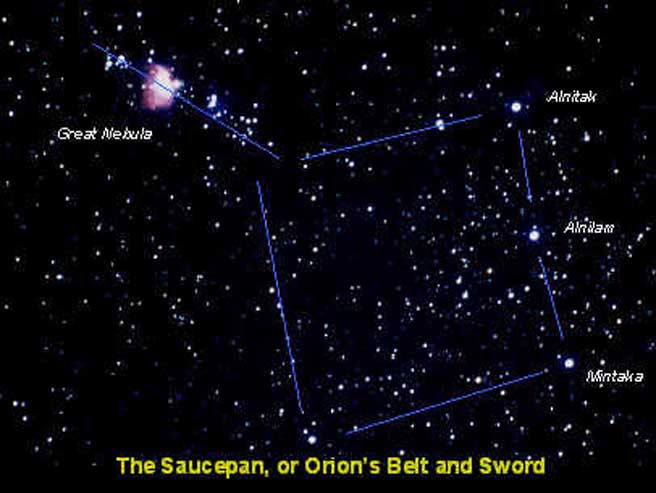
The Saucepan, with Belt at right, M42 at upper left.
Orion is quite a symmetrical constellation, with the Belt at its centre and the two shoulder stars off to the north and the two foot stars to the south. It is a
large star group, the Hunter being over twenty degrees (a little more than a handspan) tall.
The stars forming the Belt and Sword are popularly known in Australia as ‘The Saucepan’, with the Sword forming the Saucepan’s handle. Tonight this asterism appears right-side up, as in the photographs above. The faint, fuzzy star in the centre of the Sword, or the Saucepan's handle, is a great gas cloud or nebula where stars are being created. It is called the ‘Great Nebula in Orion’ or ‘M42’ (number 42 in Charles Messier’s list of deep sky objects). A photograph of it appears below:
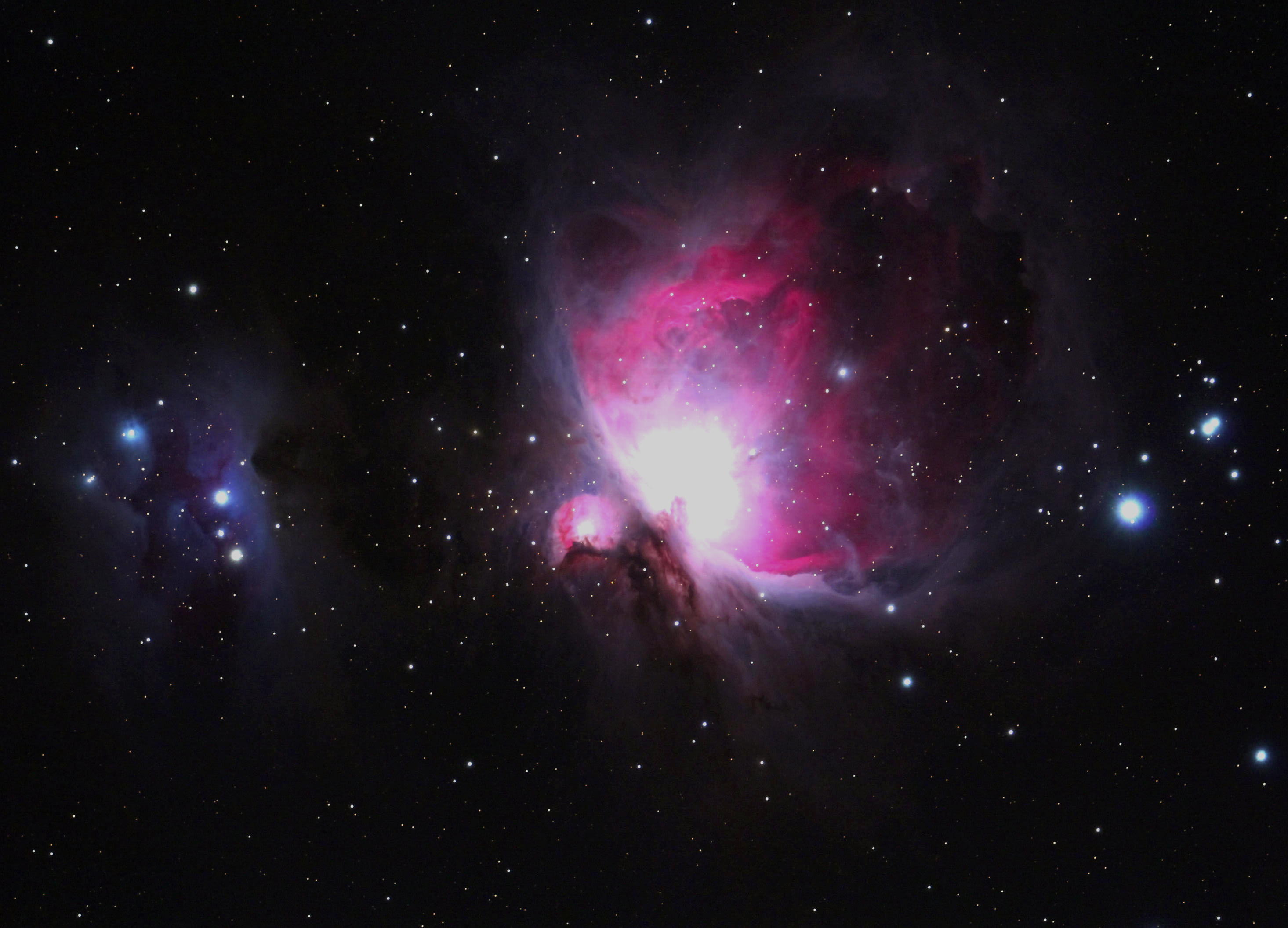
The Sword of Orion, with the Great Nebula, M42, at centre

The central section of the Great Nebula in Orion. At the brightest spot is a famous multiple star system, the Trapezium, illustrated below.
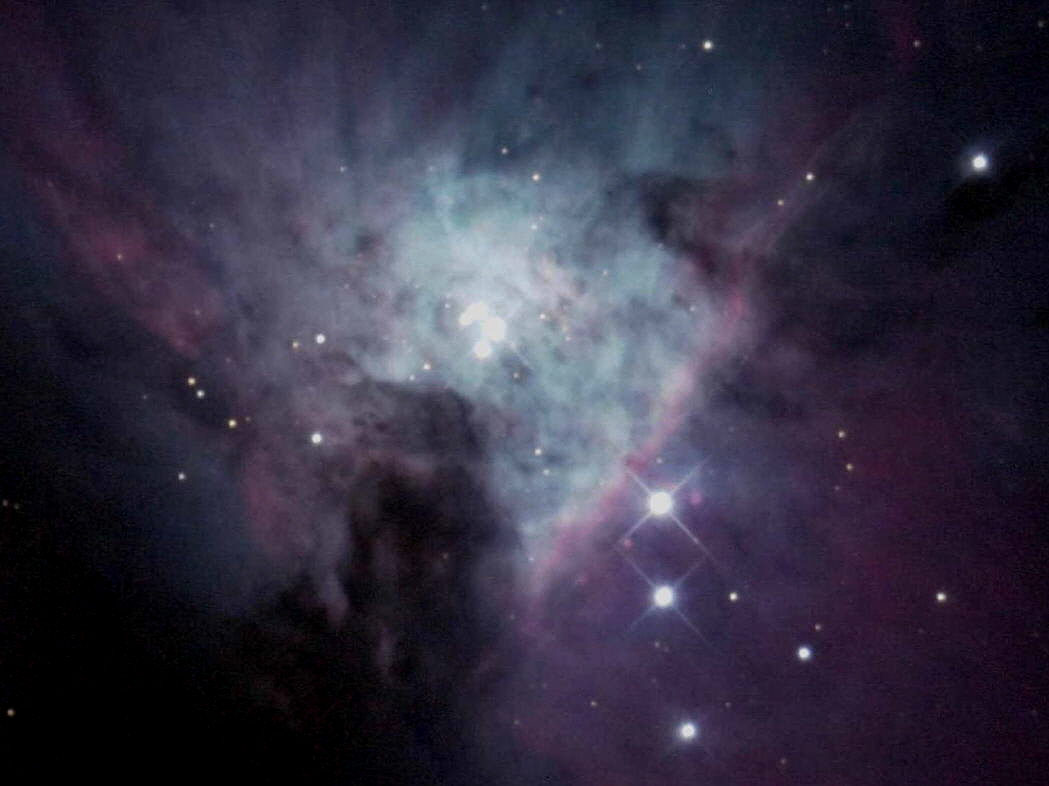
New stars are forming in the nebula. At the brightest spot is a famous multiple star system, the Trapezium, illustrated below.
Above Orion as twilight ends (facing west), a brilliant white star will be seen about one handspan away. This is
Sirius, or Alpha Canis Majoris,
and it is the brightest star in the night sky with a visual magnitude of -1.43. It marks the nose of the hunter's dog, and has been known for centuries as the
Dog Star. As we see him tonight, the dog is on his feet with his tail at upper left. A front leg stretches down from Sirius to
Mirzam, which is also
known as Beta Canis Majoris, which tells us that it is the second-brightest star in the constellation. Mirzam is about one-third of a handspan below Sirius. The hindquarters of the Dog are indicated by a large right-angled triangle of stars located above and to the left of Sirius. The end
of his tail is the top-left corner of the triangle, about one handspan south (above and to the left) of Sirius. Both Sirius and Rigel are bright white stars and each has a tiny, faint white companion. Whereas a small telescope can reveal the
companion to Rigel quite easily, the companion to Sirius the Dog Star, (called ‘the Pup’), can only be observed by using a powerful telescope with excellent
optics, as it is very close to brilliant Sirius and is usually lost in the glare
(see above).
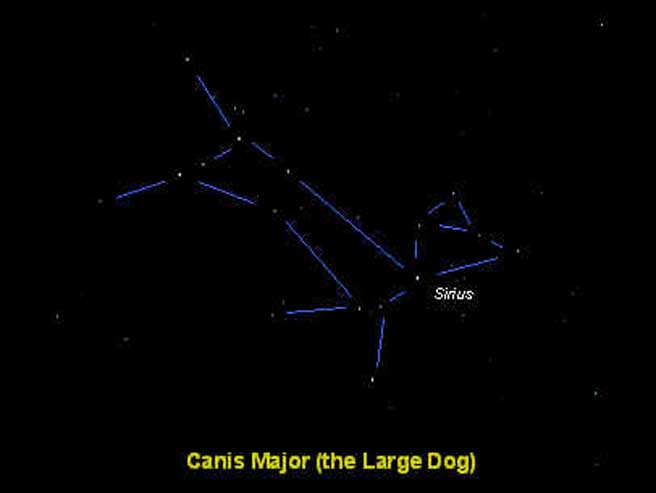

Canis Major as it appears almost overhead at 9 pm at mid-month (observer facing west).
Canis Minor
By 8 pm at mid-month, this small constellation is a little more than two handspans above the north-western horizon. It contains only two main stars, the brighter of which is Procyon (Alpha Canis Minoris). This yellow-white star of mv= 0.5 forms one corner of a large equilateral triangle, the other two corners being the red Betelgeuse and white Sirius. Beta Canis Minoris is also known as Gomeisa, a blue-white star of mv= 3.1.
Some fainter constellations
Between the two Dogs is the constellation Monoceros the Unicorn, undistinguished except for the presence of the remarkable Rosette Nebula. To the left of Orion is a small constellation, Lepus the Hare. Between Lepus and the star Canopus is the star group Columba the Dove. Underneath the star Canopus are the faint constellations Pictor (The Painter's Easel), Caelum (The Chisel), Reticulum (The Net) and Horologium (The Pendulum Clock). These were all invented by Nicolas de Lacaille and named after items in his workshop. Eridanus the River winds its way from near Orion west of the zenith to Achernar, very low in the south-south-west. The LMC lies in the constellation Dorado, with the faint constellations Mensa (Table Mountain) and Hydrus (The Water Snake) to its left. The South Celestial Pole is in the very faint constellation, Octans (Hadley's Octant).
Below the False Cross is the faint constellation of Piscis Volans (The Flying Fish), called Volans for short. Underneath and to the left of Volans is Chamaeleon, (The Chamaeleon Lizard). The Lizard has his tongue extended to catch the adjoining Fly, Musca.
Finding the South Celestial Pole
The South Celestial Pole is that point in the southern sky around which the stars rotate in a clockwise direction. The Earth's axis is aimed exactly at this point. For an equatorially-mounted telescope, the polar axis of the mounting also needs to be aligned exactly to this point in the sky for accurate tracking to take place.
To find this point, first locate the Southern Cross. Project a line from the top of the Cross (the star Gacrux) down through its base (the star Acrux) and continue straight on towards the south for another four Cross lengths. This will locate the approximate spot. There is no bright star to mark the Pole, whereas in the northern hemisphere they have Polaris (the Pole Star) to mark fairly closely the North Celestial Pole.
Another way to locate the South Celestial Pole is to draw an imaginary straight line joining Beta Centauri (a handspan above the south-south-eastern horizon) to Achernar (a handspan above the south-western horizon. At 7 pm on April 1, both stars will be at similar altitudes and the line will be almost horizontal. Bisect this line to find the pole.
Interesting photographs of this area can
be taken by using a camera on time exposure. Set the camera on a tripod pointing
due south, and open the shutter for thirty minutes or more. The rotation of the
Earth will move
the stars during the exposure, being recorded on the film as short arcs of a circle. The
arcs will be different colours, as the stars are. All the arcs will have a
common centre of curvature, which is the South Celestial Pole.
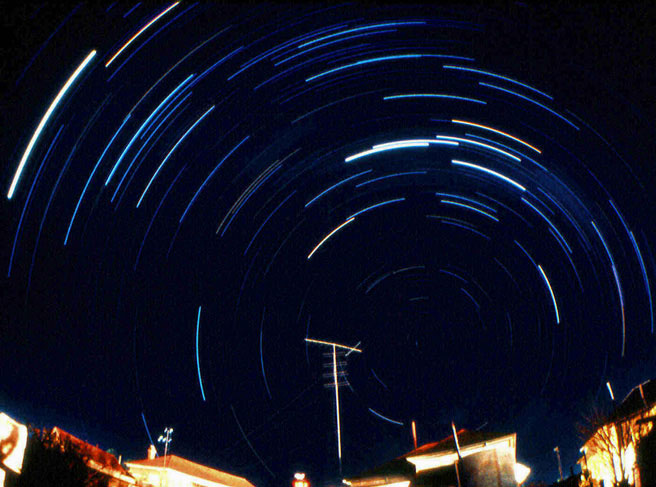
A wide-angle view of trails around the South Celestial Pole, with Scorpius and Sagittarius at left, Crux and Centaurus at top, and Carina and False Cross at right.
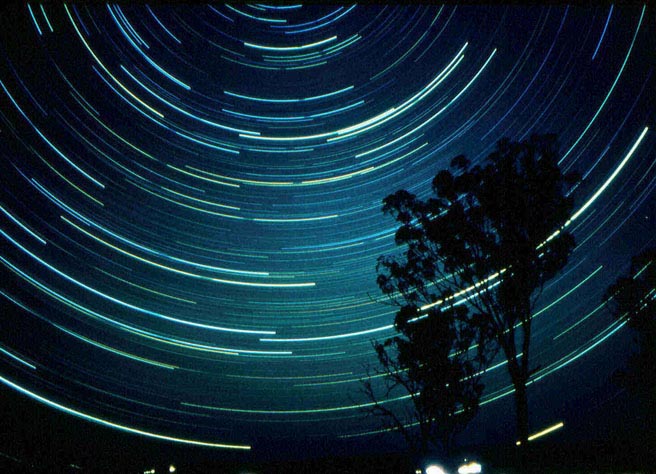
Estimates vary that between 15% and 50% of stars are single bodies like our Sun, although the latest view is that less than 25% of stars are solitary. At least 30% of stars and possibly as much as 60% of stars are in double systems, where the two stars are gravitationally linked and orbit their mutual centre of gravity. Such double stars are called binaries. The remaining 20%+ of stars are in multiple systems of three stars or more. Binaries and multiple stars are formed when a condensing Bok globule or protostar splits into two or more parts.
Binary stars may have similar components (Alpha Centauri A
and
B are both stars like our Sun - B is even said to have an Earth-sized
planet), or they may be completely dissimilar, as with Albireo
(Beta Cygni, where a bright golden giant star is paired with a smaller bluish
main sequence star).
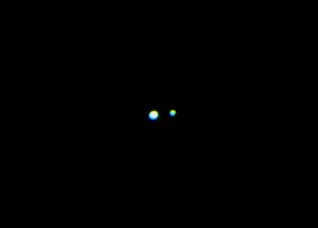

The binary stars Rigil Kentaurus (Alpha Centauri) at left, and Albireo (Beta Cygni) at right.
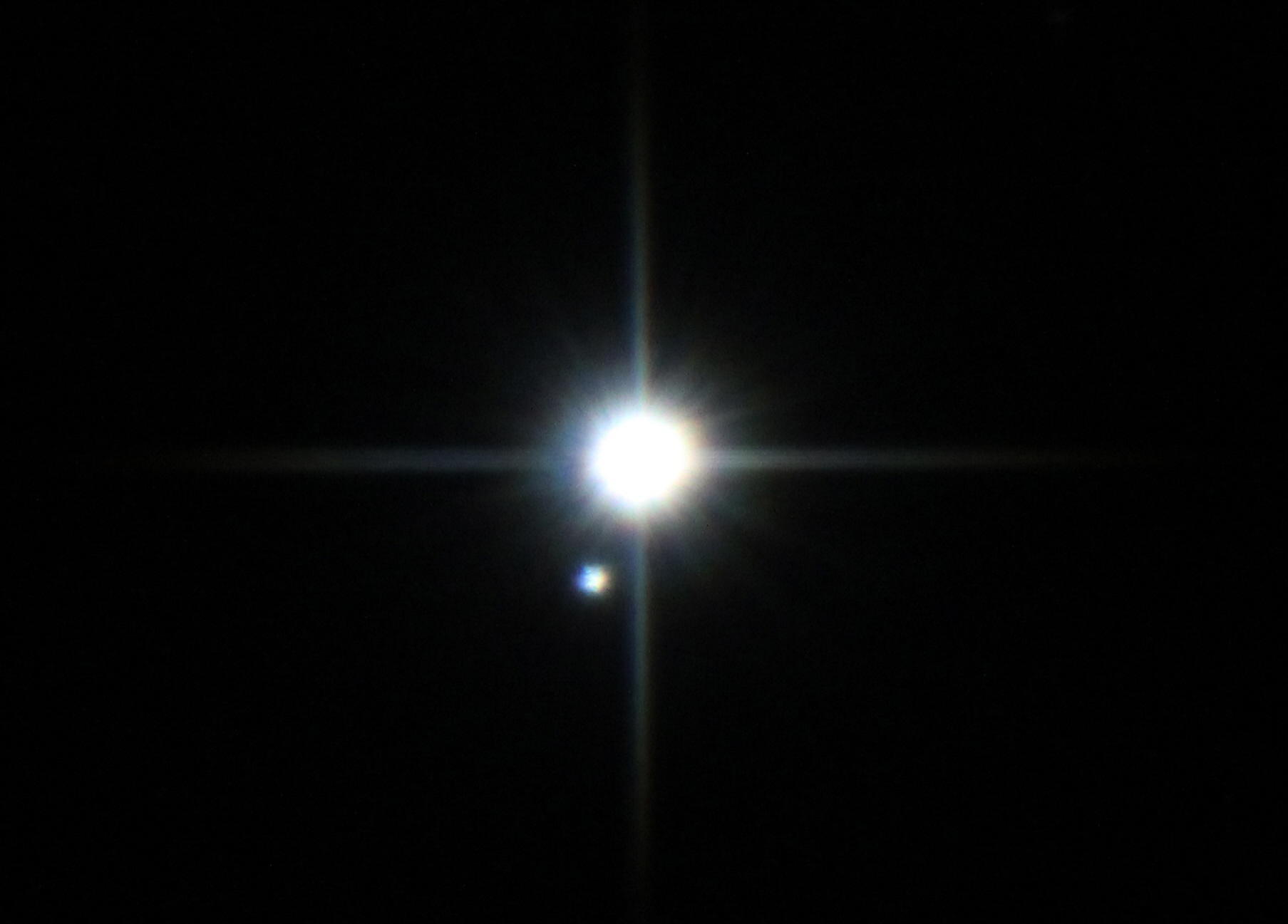
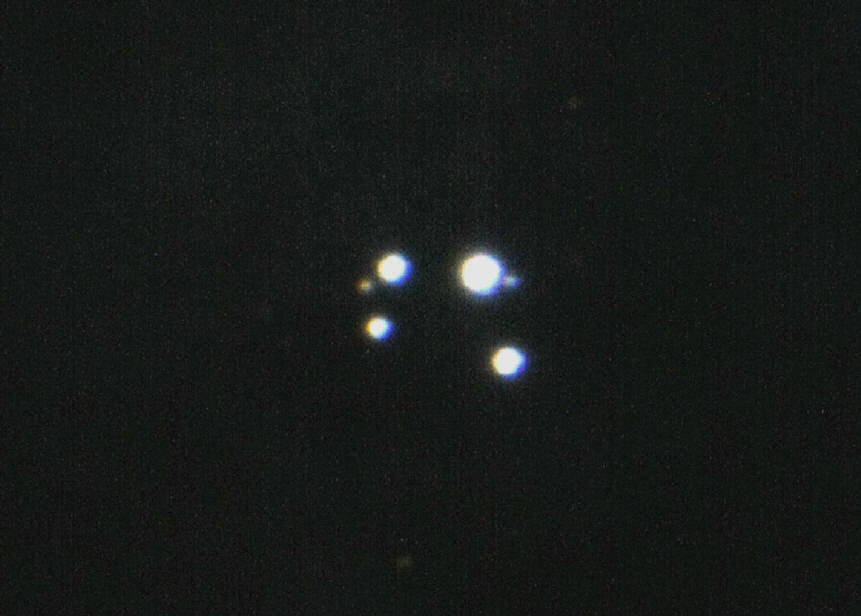
Rigel (Beta Orionis, left) is a binary star which is the seventh brightest star in the night sky. Rigel A is a large white supergiant which is 500 times brighter than its small companion, Rigel B, Yet Rigel B is itself composed or a very close pair of Sun-type stars that orbit each other in less than 10 days. Each of the two stars comprising Rigel B is brighter in absolute terms than Sirius (see above). The Rigel B pair orbit Rigel A at the immense distance of 2200 Astronomical Units, equal to 12 light-days. (An Astronomical Unit or AU is the distance from the Earth to the Sun.) In the centre of the Great Nebula in Orion (M42) is a multiple star known as the Trapezium (right). This star system has four bright white stars, two of which are binary stars with fainter red companions, giving a total of six. The hazy background is caused by the cloud of fluorescing hydrogen comprising the nebula.
Acrux, the brightest star in the Southern Cross, is also known as Alpha Crucis. It is a close binary, circled by a third dwarf companion.
Alpha Centauri (also known as Rigil Kentaurus, Rigil Kent or Toliman) is a
binary easily seen with the smallest telescope. The components are both
solar-type main sequence stars, one of type G and the other, slightly cooler and
fainter, of type K. Through a small telescope this star system looks like a pair
of distant but bright car headlights.
Alpha Centauri A and B take 80 years to complete an orbit, but a tiny third component, the 11th magnitude red dwarf Proxima Centauri, takes about 1 million years to orbit the other two. It is about one tenth of a light year from the bright pair and a little closer to us, hence its name. This makes it our nearest interstellar neighbour, with a distance of 4.3 light years. Red dwarfs are by far the most common type of star, but, being so small and faint, none is visible to the unaided eye. Because they use up so little of their energy, they are also the longest-lived of stars. The bigger a star is, the shorter its life.

Alpha Centauri, with Proxima

Knowing the orbital period of the two brightest stars A and
B, we can apply Kepler’s Third Law to find the distance they are apart. This
tells us that Alpha Centauri A and B are about 2700 million kilometres apart or
about 2.5 light hours. This makes them a little less than the distance apart of
the Sun and Uranus (the orbital period of Uranus is 84 years, that of Alpha
Centauri A and B is 80 years.)
Albireo (Beta Cygni) is sometimes described poetically as a large topaz with a small blue sapphire. It is one of the sky’s most beautiful objects. The stars are of classes G and B, making a wonderful colour contrast. It lies at a distance of 410 light years, 95 times further away than Alpha Centauri.
Binary stars may be widely spaced, as the two examples just mentioned, or so close that a telescope is struggling to separated them (Acrux, Castor, Antares, Sirius). Even closer double stars cannot be split by the telescope, but the spectroscope can disclose their true nature by revealing clues in the absorption lines in their spectra. These examples are called spectroscopic binaries. In a binary system, closer stars will have shorter periods for the stars to complete an orbit. Eta Cassiopeiae takes 480 years for the stars to circle each other. The binary with the shortest period is AM Canum Venaticorum, which takes only 17½ minutes.
Sometimes one star in a binary system will pass in front of the other one, partially blocking off its light. The total light output of the pair will be seen to vary, as regular as clockwork. These are called eclipsing binaries, and are a type of variable star, although the stars themselves usually do not vary.
Star clusters
The two clusters in Taurus, the Pleiades and the Hyades, are known as Open Clusters or Galactic Clusters. The name 'open cluster' refers to the fact that the stars in the cluster are grouped together, but not as tightly as in globular clusters (see below). The stars appear to be loosely arranged, and this is partly due to the fact that the cluster is relatively close to us, i.e. within our galaxy, hence the alternate name, 'galactic cluster'. These clusters are generally formed from the condensation of gas in a nebula into stars, and some are relatively young.
The photograph below shows a typical open cluster,

Galactic Cluster M7 in Scorpius
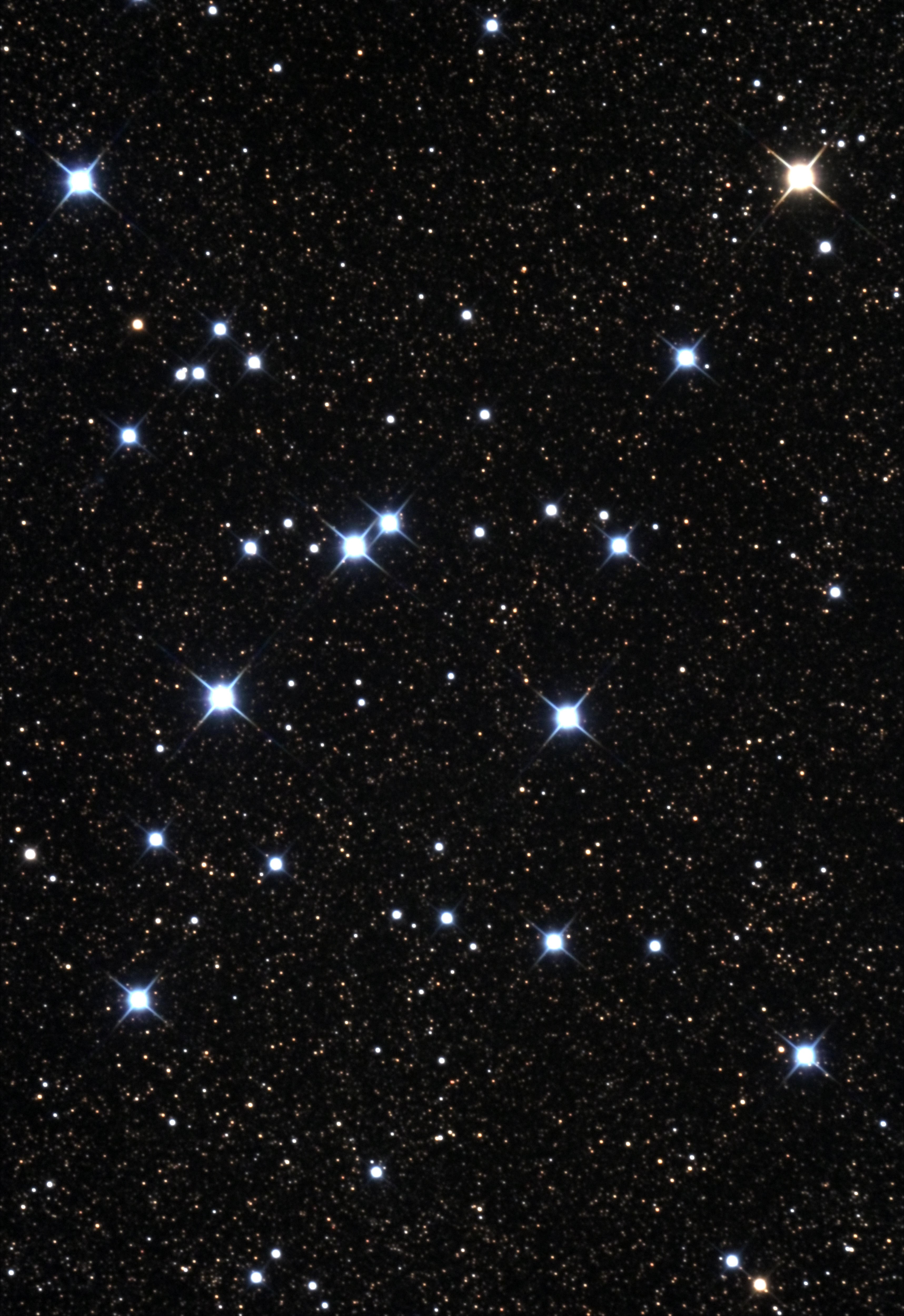
Outside the plane of our galaxy, there is a halo of Globular Clusters. These are very old, dense clusters, containing perhaps several hundred thousand stars. These stars are closer to each other than is usual, and because of its great distance from us, a globular cluster gives the impression of a solid mass of faint stars. Many other galaxies also have a halo of globular clusters circling around them.
The largest and brightest globular cluster in the sky is
NGC 5139**,
also known as
Omega Centauri. It has a slightly oval shape. It is an outstanding winter
object, but is close to the horizon in summer. Shining at fourth magnitude, it
is faintly visible to the unaided eye, but is easily seen with binoculars, like
a light in a fog. A telescope of 20 cm aperture or better will reveal its true
nature, with hundreds of faint stars giving the impression of diamond dust on a
black satin background. It lies at a distance of 5 kiloparsecs, or 16 300 light
years.
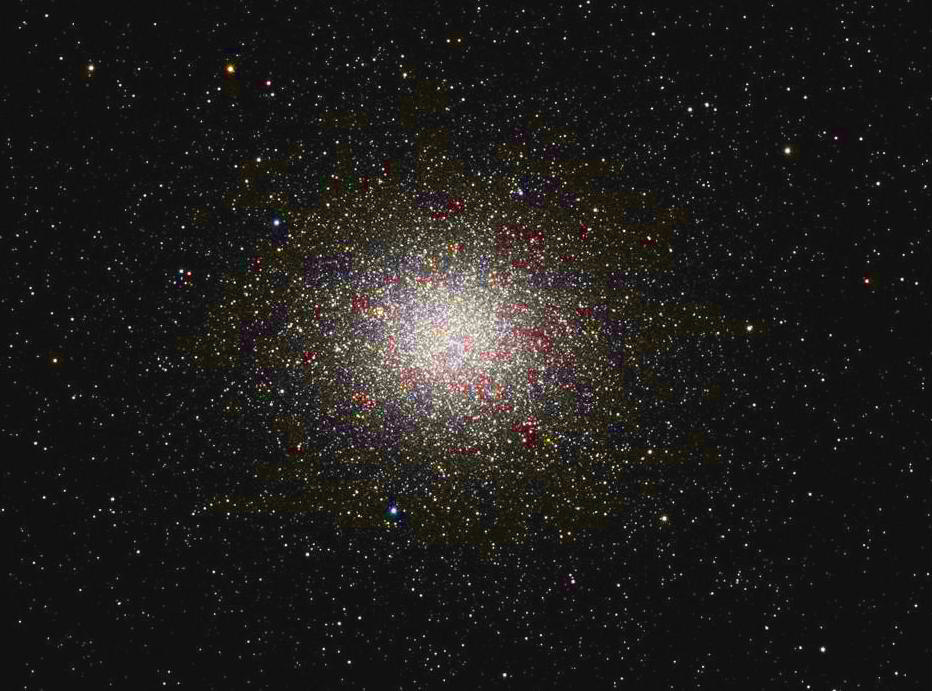

The central core of Omega Centauri
There is another remarkable globular, second only to Omega Centauri. About two
degrees below the SMC (see below), binoculars can detect a fuzzy star. A
telescope will reveal this faint glow as a magnificent globular cluster, lying
at a distance of 5.8 kiloparsecs. Its light has taken almost 19 000 years to
reach us. This is

Globular Cluster NGC 104 in Tucana
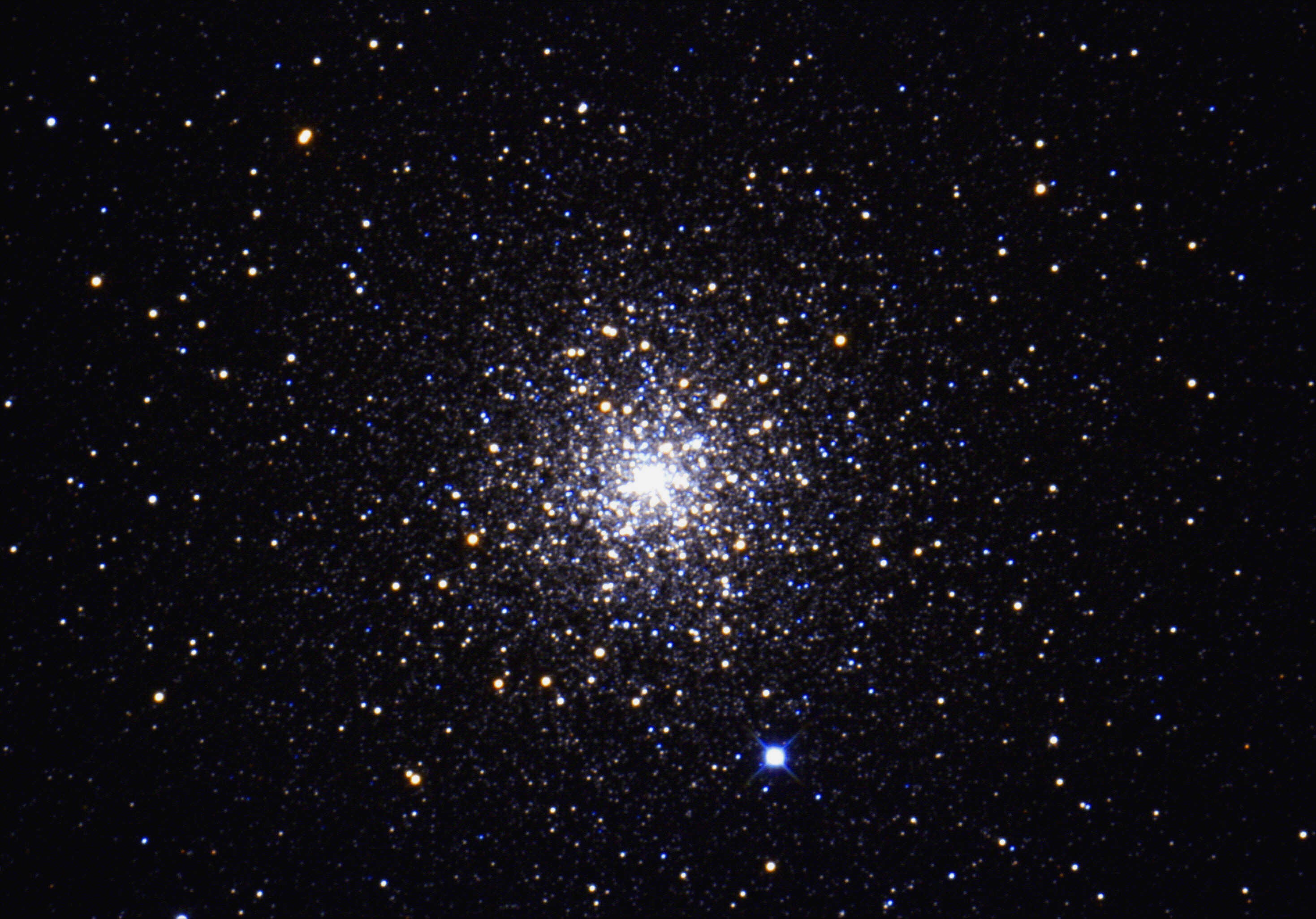
Observers aiming their telescopes towards the SMC generally also look at the
nearby 47 Tucanae, but there is another globular cluster nearby which is also
worth a visit. This is
* M42: This number means that the Great Nebula in Orion is No. 42 in a list of 103 astronomical objects compiled and published in 1784 by Charles Messier. Charles was interested in the discovery of new comets, and his aim was to provide a list for observers of fuzzy nebulae and clusters which could easily be reported as comets by mistake. Messier's search for comets is now just a footnote to history, but his list of 103 objects is well known to all astronomers today, and has even been extended to 110 objects.
** NGC 5139: This number means that Omega Centauri is No. 5139 in the New General Catalogue of Non-stellar Astronomical Objects. This catalogue was first published in 1888 by J. L. E. Dreyer under the auspices of the Royal Astronomical Society, as his New General Catalogue of Nebulae and Clusters of Stars. As larger telescopes built early in the 20th century discovered fainter objects in space, and also dark, obscuring nebulae and dust clouds, the NGC was supplemented with the addition of the Index Catalogue (IC). Many non-stellar objects in the sky have therefore NGC numbers or IC numbers. For example, the famous Horsehead Nebula in Orion is catalogued as IC 434. The NGC was revised in 1973, and lists 7840 objects.
The recent explosion of discovery in astronomy has meant that more and more catalogues are being produced, but they tend to specialise in particular types of objects, rather than being all-encompassing, as the NGC / IC try to be. Some examples are the Planetary Nebulae Catalogue (PK) which lists 1455 nebulae, the Washington Catalogue of Double Stars (WDS) which lists 12 000 binaries, the General Catalogue of Variable Stars (GCVS) which lists 28 000 variables, and the Principal Galaxy Catalogue (PGC) which lists 73 000 galaxies. The largest modern catalogue is the Hubble Guide Star Catalogue (GSC) which was assembled to support the Hubble Space Telescope's need for guide stars when photographing sky objects. The GSC contains nearly 19 million stars brighter than magnitude 15.
Two
close galaxies
High in the south-south-west, below and t
o the left of Canopus, two large smudges of light may be seen. These are the two Clouds of Magellan, known to astronomers as the LMC (Large Magellanic Cloud) and the SMC (Small Magellanic Cloud). The LMC is to the right and above the SMC, and is noticeably larger. They lie at a distance of 160 000 light years, and are about 60 000 light years apart. They are dwarf galaxies, and they circle our own much larger galaxy, the Milky Way. The LMC is slightly closer, but this does not account for its larger appearance. It really is larger than the SMC, and has developed as an under-sized barred spiral galaxy.
From our latitude both Magellanic Clouds are circumpolar. This means that they
are closer to the South Celestial Pole than that Pole's altitude above the
horizon, so they never dip below the horizon. They never rise nor set, but are
always in our sky. Of course, they are not visible in daylight, but they are
there, all the same.
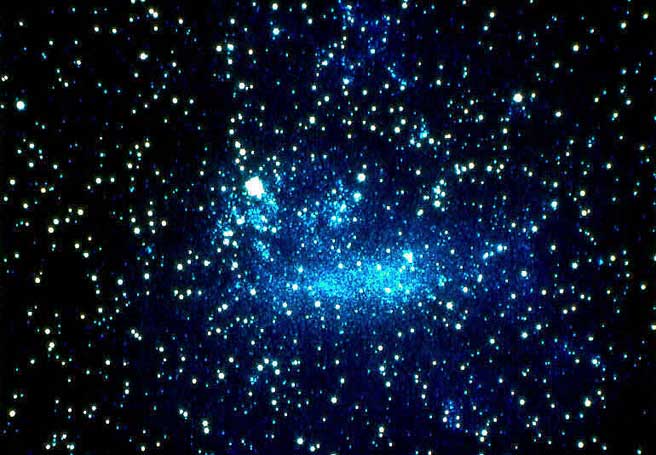
The Large Magellanic Cloud - the bright knot of gas to left of centre is the famous Tarantula Nebula (below)

These two Clouds are the closest galaxies to our own, but lie too far south to
be seen by the large telescopes in Hawaii, California and Arizona. They are 15
times closer than the famous Andromeda and Triangulum galaxies, and so can be
observed in much clearer detail. Our great observatories in Australia, both
radio and optical, have for many years been engaged in important research
involving these, our nearest inter-galactic neighbours.
Why are some constellations bright, while others are faint ?
The Milky Way is a barred spiral galaxy some 100000 – 120000 light-years in diameter which contains 100 – 400 billion stars. It may contain at least as many planets as well. Our galaxy is shaped like a flattened disc with a central bulge. The Solar System is located within the disc, about 27000 light-years from the Galactic Centre, on the inner edge of one of the spiral-shaped concentrations of gas and dust called the Orion Arm. When we look along the plane of the galaxy, either in towards the centre or out towards the edge, we are looking along the disc through the teeming hordes of stars, clusters, dust clouds and nebulae. In the sky, the galactic plane gives the appearance which we call the Milky Way, a brighter band of light crossing the sky. This part of the sky is very interesting to observe with binoculars or telescope. The brightest and most spectacular constellations, such as Crux, Canis Major, Orion, Scorpius and Sagittarius are located close to the Milky Way.If we look at ninety degrees to the plane, either straight up and out of the galaxy or straight down, we are looking through comparatively few stars and gas clouds and so can see out into deep space. These are the directions of the north and south galactic poles, and because we have a clear view in these directions to distant galaxies, these parts of the sky are called the intergalactic windows. The southern window is in the constellation Sculptor, not far from the star Fomalhaut. This window is below the horizon in the early evenings this month. The northern window is between the constellations Virgo and Coma Berenices, roughly between the stars Denebola and Arcturus. It begins to rise in the east-north-east at sunset at mid-month, and is well placed for viewing at midnight.
Some of the fainter and apparently insignificant constellations are found around these windows, and their lack of bright stars, clusters and gas clouds presents us with the opportunity to look out across the millions of light years of space to thousands of distant galaxies.
Astronomy Picture of the Day
Click
Virtual Moon freeware
Study the Moon in close-up, spin it around to see the far side, find the names and physical attributes of craters, seas, ranges and other features, by clicking
Calsky software
Check out where the planets and their moons are, as well as most other sky objects, by clicking here.
Stellarium freeware
New version. Check out where the stars and constellations are, as well as most other sky objects, by clicking
here.
Observatory Home Page and Index